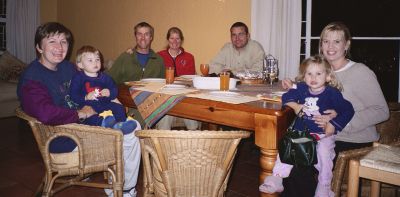South Africa 2003 Travelogue
Entries:
Hello South Africa!
June 23, 2003, Singapore to Johannesburg, South Africa:
The flight to South Africa was very smooth. At first, they had some problems with the entertainment system and we couldn't watch any movies. But after a while, they reset the whole thing, and it worked! I saw "Daredevil" (Better than expected), "The Recruit" (Very Good), "National Security" (Lousy), and an episode of "Friends" and "Whose Line Is It Anyway?". Donna watched "The Recruit" (Good), "How to Lose a Guy in 10 Days" (Funny), "The Guru" (Silly), "The Phone Booth" (Better than she thought), and part of "Tomb Raider" (it was cool to see the parts of Angkor Wat that we had been to!). It was a long flight (10 hours!).
We made it through customs and baggage claim fairly quickly with no hassles. We exchanged our money and got more from an ATM. We didn't get too much since Jo'burg is known for crime, and we didn't want to lose much if we were robbed. Next step was to figure out how to get to the train station so we could take a train to Cape Town. The Lonely Planet mentioned that there is a shuttle bus that goes direct to the train station from the airport, but it turns out this is no longer true. After investigating all the options, we went with a taxi. He took us there for 170 Rand (7.7 Rand per US Dollar). When we got to the train station, we got out, I paid him, and he walked us all the way into the station where the ticket desk is. Outside there were several people with "Metro Crime Patrol" jackets on patrolling the parking lot. I suspect they were preventing crime.
We had arrived at 7:30 AM. The ticket office didn't open until 8:00. We found a table and settled down and had a cup of Milo (similar to hot chocolate) while waiting for the ticket office to open. It was quite cold here 50F or so, I would say. We were bundled up in our fleece, wool caps and gloves. After 8, I went and got us tickets. The 2nd class was full; we could only get 1st class tickets. Oh well, it turns out we got our own compartment! It cost 860 Rand ($111) for the both of us to Cape Town. That is about half the cost that flying would have been, and only marginally more than a bus. Travel is very expensive here compared to what we have been used to! It turns out our train wasn't scheduled to leave until 12:30 PM, and we could start boarding at 11:30 AM. So we settled in, and played lots of cards, people-watched and had some more food from the little cafe.
At 11:30, we headed downstairs to wait on the platform for the train. We set our stuff down and started waiting. We were the only white folks in this particular section, and we sat there watching the people around us or playing cards. They were definitely watching us. A couple of people spoke to us, but most just stared. Later, when Donna went to the bathroom to change pants (she was in thin pants from Thailand and was freezing), a black woman expressed concern to me because she thought she saw a man follow Donna to the restroom. I went to the restroom and called for Donna to make sure she was OK. We never saw the man. It was nice of the lady to look out for us. After 12:00, we heard an almost unintelligable announcement about a train being delayed 3 hours and 45 minutes. It was hard to hear, so I tried to find out if it was about our train. The guy at the information booth didn't know. We waited and waited. After 1:00 PM they announced our train wouldn't arrive till 4:00 PM! We were starved. So I went up and got us some meat pies and some water. We had lunch, and played more cards. Eventually, a train came in to our platform. Everyone got up and got their stuff. We headed to where our car was going to be (at the other end of the platform), but it turned out that this wasn't our train. It was going from Cape Town to Pretoria. Ours would be coming from Pretoria heading to Cape Town. This time we waited at this end of the platform on one of the benches. At around 3:00 PM, our train pulled in and everyone got on board. Our car (#16) was at the very front of the train, right behind the engine cars. We found our compartment (C); it was small, but there were just two of us. It was a two bunk setup, with the bunks perpendicular to the train on one wall, and a table/sink on the other wall. We could close the door and get complete privacy! The door locked while you were inside, but you couldn't lock it when you left the room. We settled in and turned on the heater. It wasn't working, since we weren't moving yet.
Eventually we were underway. The ride was nice that afternoon, we remarked that the Jo'burg area felt a lot like Colorado. They came by and checked our tickets, and gave us some toilet paper and soap too. However it turns out that even in 1st class you have to pay for linens if you want them. We didn't have our sleeping bags, so we went ahead and paid the 50 rand each to rent the linens and blankets. They would come by later to deliver them. Around 5, we went to the dining car for dinner and we split a steak and chips. It was great! Nice to have beef again! After dinner, it took a while for them to bring by the linens. Once they finally did, we hit the sack. It was nice and warm when we went to bed, but during the night, the heater system failed. Then, it got downright chilly! It was OK under the covers, but we needed to put our socks back on.
June 24, 2003, Cape Town, South Africa:
At 9:00 AM I was starving. I woke Donna up, and we headed back to the dining car for breakfast. While waiting for our breakfast to be prepared, we started playing cards (Palace). A few minutes later, one of the waiters came over and told us that the manager has forbidden games to be played in the dining car! He told us we could finish the hand we were playing, but we weren't to start another. We figured they are either trying to prevent gambling, or don't want people to stay at the tables when not eating and just playing cards. Oh well. After breakfast we went back to the compartment for more reading/journalling/card playing. Then, we had lunch and and went back to the compartment for more sightseeing/card playing. At one point the conductor came by and told us we would be arriving in Cape Town about 3 hours late at 5:15 PM. We asked about the lack of heat, and he mentioned that the ignitor panel had died during the night, and it wouldn't be fixed before we arrived in Cape Town. However, we could keep our blankets until we got in since it was so cold. About 20 minutes later, another steward came by to pick up the linens! I asked him to come by as late as possible so we could keep them since it was so cold. He came by and took them while we went for our late lunch. That afternoon, we listened to our CD's and Donna did more journalling. The train was a bit warmer due to the sun heating it.
We arrived in Cape Town around 5:15. As we were going out, they were taking the train tickets! Ooops, we had packed ours with Donna's journal deep inside her pack! We dug it out and made our way through. We had read that a good cheap way to get to our hostel was to take a mini-bus taxi that were on the roof of the train station. We made our way up there and asked about it, and showed them where we wanted to go. One lady was very nice and tried to figure out where we should go. It turned out we needed to take another taxi. She helped arrange it for us and we took a cab to our hostel for 30 rand.
We are staying at Zebra Crossing (82 New Church Street, Cape Town 8001 Tel/Fax:27-21-422-1265, Email:
zebracross@intekom.co.za) It is in the City Bowl area. It looks like there are lots of museums and other sights within walking distance of here. At first, they showed us a very large double for 170 rand, but it had two beds and we would rather have one and something cheaper. They finally showed us a single that had a bed about 1 1/2 people wide. It was quite small, but the same price we would have paid if we both stayed in the dorms. It was 120 rand ($15.78) South Africa is MUCH more expensive than India or SE Asia that we are used to. We will be making our own food to save on expenses! The room seems to be what used to be the front porch, and was later walled in to make a room. We checked internet and had got our friend Jenny Rae's phone number. She is in Cape Town now. We had met her in back in Thailand on our hill tribe trek! We called her and we are planning to hook up with her and maybe volunteer on a Habitat for Humanity work site. Finally, we had some dinner in the cafe and went to bed.
June 25, 2003, Cape Town, South Africa:
The downside to our room location is that everyone goes out the gate by our room to get to their cars, and they bang the gate each time they go through -- at all hours! Otherwise it works well. We just have to be economical with our space. We got up had our devotional time, and had some nice HOT showers! Then, we went off to the cafe at the hostel for breakfast. I was very hungry, and this would probably be one of our last purchased meals in South Africa.
After breakfast, we went out and got more money at the ATM in the mall. You should only use ATMs indoors here and you have to be very careful. We got some groceries for the next few days, and then headed to the internet cafe to work on the Singapore post. That evening Donna made a wonderful spaghetti dinner. This was the first time she has cooked in over 5 months! It feels a lot like being back in New Zealand, with the hostel atmosphere and self catering and all. I chatted with some other people in the hostel. They were cyclists. One guy from Ireland rode his bicycle here all the way from Ireland! He had put on 17,000 km! Unfortuately, his bike was stolen only 10 days ago. He is trying to figure out what to do now. Apparently, it is very hard to buy a touring bike here. His friend is from France and he rode from Paris to the northern portion of Norway, and then all the way down here to Cape Town! He did a more circuitous route, and put on over 36,000 KM. After dinner, we called my mom. She was very grateful for the call. We are finally in a country that accepts our calling cards! Hooray!
Tomorrow, maybe we will actually get out to see some of the sights of Cape Town!
Cape Town-Tourism & Volunteerism
Thursday, June 26, 2003, Cape Town, South Africa:
At around 4:00 AM someone leaves our hostel. We know this because they slam the gate right outside our door as they go out! We went back to sleep and got up at a more reasonable hour. We make all our own meals now. I have corn flakes with a banana and tea, Donna has two pieces of toast with peanut butter and a banana and tea or hot chocolate.
Next stop was the internet cafe. Donna finished off the Singapore post, and I put it on the web page and then did our first post from South Africa. Then it was off to the larger, cheaper grocery store, Checkers, for more groceries and back to the hostel for lunch.
At lunch, we taught one of the office girls, Haneke (she's from Holland), palace. She really likes to play cards! We played cards with her for a few hours. Finally, we decided to go out for a walk before it got dark. We wanted to do some sightseeing today.
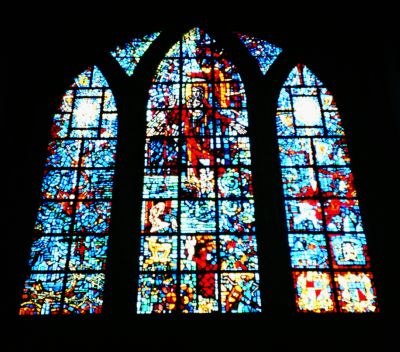
St George's Stained Glass
|
We went out and did part of the walking tour that is in the Lonely Planet we have. We went down to the Company Gardens first. They were put in by the Dutch Company that ran South Africa long ago. They were very nice gardens. The gardens also contain the South Africa Museum and Planetarium. It was too late to go in today, but we will go see it before we leave. We walked the length of the park, past the Delville Wood Memorial, and then past a little aviary they had. We saw probably the fattest pigeons in that aviary that we have ever seen! We soon found out why they were so fat. Many people feed them through the fence. They also had a very unusual-looking, colorful duck. We passed by the back side of the Parliament building, and then on to the other end of the park where St George's Cathedral stands.
We stopped in and it is gorgeous! It was designed by Herbert Baker and built in 1897. It was Archbishop Desmond Tutu's cathedral. When we walked in we heard singing. It was beautiful harmonies with an African sound of some sort. To the right of the altar is a wonderful, enormous rose window with an African theme. It is the most beautiful rose window Donna has seen! (I reserve my judgment).
After St George's, we headed back up Long Street towards our hostel. We were going back a bit early, so we would have time to make dinner. We made spaghetti for dinner. I helped out so it went a bit smoother than the previous night. After dinner and a few card games, we decided to go see the movie "
Anger Management" at the
Labia theater nearby. It was cute, not great, but OK. Donna never thought she would see a movie with Adam Sandler and Jack Nicholson as co-stars!
Friday, June 27, 2003, Cape Town, South Africa:
After breakfast, we went to the internet shop, and then did some errands. Then, we had lunch back at the hostel. After lunch, we decided to drop off our film and go do some errands. We dropped the film at Orm's. It was recommended to us by the guys at our internet cafe. Orm's is good and cheaper than the other local shops, but more expensive than we had in Asia. There we could develop a roll and get a CD made for $6. Here it is around $10 per roll. It was quite a walk to Orm's, but it was near the
District 6 Museum, so we went there after dropping off the film.
District 6 is a rather large area, right in the middle of Cape Town. It was a very integrated and heavily populated area. It was mostly populated with "Coloreds" but also had many blacks. "Coloreds" were non-whites who weren't native Africans. Much of the housing was dilapidated and the people were poor. They had lived there for many generations; it was their home. The neighborhoods took care of one another. In the 1960's, under the auspices of apartheid, District 6 was declared an all-white neighborhood and thousands of blacks & coloreds who lived there were forced to move out to the townships. The museum explains the history of District 6 and the pass laws that existed during apartheid. Pass laws forced colored and black persons to carry passes that controlled where they could go. Parts of District 6 are now being returned, in part, to many of the original residents. The
District 6 museum is definitely a must-see for any Cape Town visitor!
Next, we headed over to the Groote Kerk church, a Dutch Reformed Church. Unfortunately, we thought it would be open until 4:00 PM, but it closes at 2:00. Oh well. Then it was on to Greenmarket Square, a cobblestone square, which was created as a farmer's market in the early 18th century. When we arrived, we found it filled with vendors! They were selling all sorts of arts & crafts. It was interesting - it was like being back at the markets in SE Asia, but very very different. Eventually, in Asia, you realize that everything that is being sold is the same. It may take a while to see it all, but eventually, you do, and then it's all repetitive. But this was all new! No repetition, and it was fun to look at! It was hard not to linger and show too much interest. We don't have any money to spend, after all!
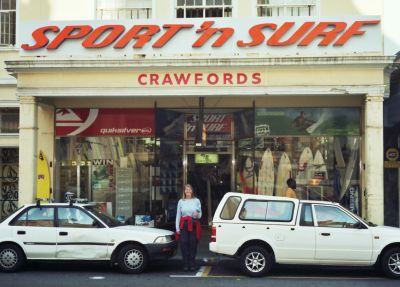
Our Store! |
There was a beautiful old church on the corner that we wanted to visit, but it was all closed up. We decided to head for another museum. As we approached the next one we saw a funny sight, right across the street from our museum was a sporting goods store called "Crawfords"! Of course I had Donna stand out front while I took a picture!

The museum was the "
South African Misionary Meeting-House Museum". The museum essentially documents the efforts of preaching the gospel to the black population of South Africa. This building was first built for that specific purpose. There is also a section of the museum dedicated to the issue of slavery in South Africa, which you don't hear much about. We left just as they closed for the day.
We headed back to the grocery store to get some meat for dinner, and then we split up. Donna went back to the hostel to cook dinner, and I walked back to the camera store to get our pictures. Donna was a little worried about me going by myself all that way through the city, but she prayed a blessing on me, and I was off. I walked quickly and with purpose, and got the film and made it back before she had dinner ready. We had pork and cheese-potatoes. Very Good! After dinner, we hung out, labeled our photos, and then went to the internet shop where I uploaded them to the website.
Saturday, June 28, 2003, Cape Town, South Africa:
When Donna took her shower this morning, she got to be the lucky person that the water just stopped on. Fortunately she had rinsed her hair out when it happened!
After breakfast, we went to the internet cafe and I finished uploading the pictures, and fixed some problems with the links. Then we bought a phone card. We were tired of dealing with coins.
We went back to the hostel, I went over the labels on our pictures, to make sure we no longer needed our guide books and could now sell them. Donna wrote in her journal and we played more cards. We planned to go to a 5:30 PM movie in the afternoon. We went to a movie called "
Far From Heaven" with Julianne Moore & Dennis Quaid. It was good, but kinda depressing. It shows how homosexuality can destroy lives. Another theme in the movie wasn't resolved however, the tension between blacks & whites. After the movie, we had dinner at the hostel, pork chops and fries, Yummy!
Sunday, June 29, 2003, Cape Town, South Africa:
We've officially been on the road 9 months today. It feels like longer! We slept in a bit today, had breakfast, and then called a
rikki to take us to the waterfront. A "rikki" is kinda between a taxi and a mini bus. They use Suzuki micro buses and you sit in the back in two rows like a saeng-thaew in SE Asia. They have set prices for different regions.
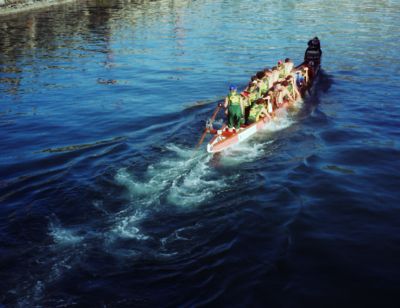
A Dragon Boat |
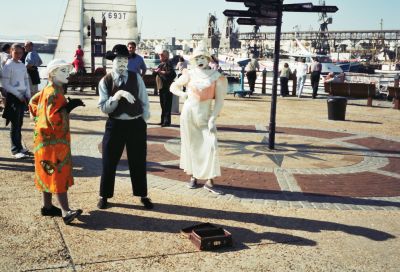
The Mimes |

The Abalendeli Brothers |
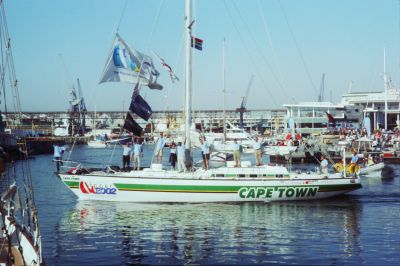
Cape Town Entry in Clipper 2002 |

Donna with Table Mountain in background |
At the waterfront, we booked our tickets to Robben Island on Tuesday morning. The 9:00 AM boat to the island is only 60 Rand while the others are 150 Rand. We reserved the 9:00 AM trip of course!
Next we headed around the waterfront area looking at all the shops and people and boats and stuff. It was very active, lots of buskers were out, singers, musicians, fire-eaters, etc. At the Hildebrand there was a microphone set up and a speaker was talking. It was the continuation of a round-the-world yacht race! The race is the
Clipper 2002. They started from Liverpool last September and will return there this September. Their next stop after Cape Town is Brasil. Cool! We saw entries from New York, Jersey, London, Glasgow, Hong Kong, Cape Town, Liverpool, and Brighton, among others.
We kept walking and saw lots more musicians. We saw one group of 8 African men that were awesome! They were singing acapella harmonies. They sounded fantastic! They were called the "Abalandeli Brothers" We stayed and listened for a while. At one point a tiny little boy ran up to them and was dancing and looking at them from very close up. Part of their act involves synchronized movements/dancing and the boy was sort of in the way. But the men were great! They played up to him perfectly. It was very cute. Eventually we decided to blow our budget and buy the CD.
Next we went off to have some lunch. Donna tried to pull out her little money pouch so we could pay, and we found that it was missing! This was NOT a good thing. She was positive she had put it on today, and thought it may have fallen out when she used the toilet right before we came to the waterfront. We hoped someone would be honest and turn it in. It had her hostel card and 200 Rand ($25) in it. The tricky part was since we had just bought the CD, we barely had enough money to cover the pizza slices we just ordered and a rikki home. I sent back one of the drinks, so we would have enough. We prayed that we might find the pouch or that God would provide. As we were leaving the pizza place with our slices, we stopped at a counter with our food. We were talking and Donna took a step to go to the table, and I looked down, her pouch had just fallen out of her pants! Praise God! He works very fast sometimes! If it had fallen out anywhere else, we probably wouldn't have noticed. Donna went back and we bought our other drink.
After lunch, we walked around more, and saw more buskers. They move around from site to site in the waterfront. We saw some we had seen earlier in the day that were hilarious! They were sort of like mimes. They were all blacks with their faces painted white, and wearing old fashioned clothes. They would stand in frozen poses, and when someone would throw money into their basket, they would move. But the trick is, the larger the amount of money, the more the movement. If you throw in something small, they might just flick a finger or hand, like flicking off a fly. It was very entertaining!
We were getting a bit tired and had seen all of the area, so we called our rikki, and headed back to the hostel. In fact, we had to have our hostel call him because the normal number wasn't working. When the rikki arrived, it was the same driver. He gave us his mobile number. Apparently, the rikkis are officially closed on Sundays. Our driver does the Sunday work on the side.
That afternoon, after a grocery run, and playing cards in the hostel, we decided to go get prices on our two travel guides we had to sell. It was after 3:00 PM. We headed down Kloof towards Long Street, and twice, we were accosted by people. The second guy was quite agressive. He grabbed Donna's elbow quite hard. It hurt! She told him, "You are hurting me, Sir" and he finally let go. He started his spiel with "I am not a murderer". He was trying to get us to give him money for some thing or another. It may have been for a school, but who knows if that's where it really would go. We finally managed to get away. As we went on down the street, we noticed most of the cafes and shops were closed. I then remembered that the guide book told us not to go out on Sundays after 1:00 PM. So, we headed back to the hostel and would check prices on the book later. We went back to the hostel, ate some sandwiches and listened to our new CD. We waited until 6:30 PM when Jenny Rae and Michael came to pick us up for church.
Jenny Rae and Michael brought us to the
Claremont Methodist Church. We met some folks on the way in, and then sat in the front row. Matthew introduced himself to us. It turned out he was the pastor/speaker for the night. The service was good, the music was AWESOME! We knew all the songs from
Kings Harbor except for one! It really made us homesick! Of all the things we miss from home, one of the things we miss most is our church - our church family, worship, the consistency, accountability, etc. We are definitley looking forward to that when we get home.
After church we chatted a while and managed to get hooked up with Grant. He arranged a ride for us to the
Habitat for Humanity site the next day at 6:30 AM. We will have to get up early! Then we walked over to a restaurant called
Colorado Spur. Apparently it is a big chain here in South Africa. I had a burger, and Donna had a chicken quesadilla. We ate and chatted a while with Michael and Jenny Rae. It turns out Michael is going through quite a few changes now. He is quitting his job in two weeks, and traveling through Africa for 3 months, doing mission work along the way! Cool! He is apparently doing this rather quickly and is just telling people now. After dinner, Michael insisted on paying for our meal. Wow! We weren't expecting that. Very Cool! We took a drive along the high road back to our hostel. We had a great day. Now to bed since the morning would come VERY Early!
Monday, June 30, 2003, Khayelitsha, South Africa:
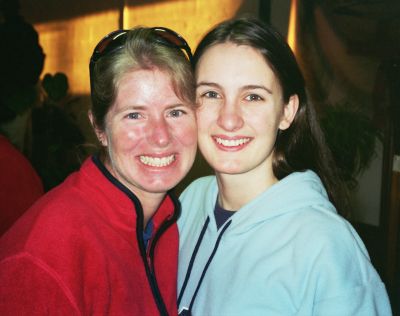
Donna and Sarah
|

The house we worked on |

Making Daga (Cement) |
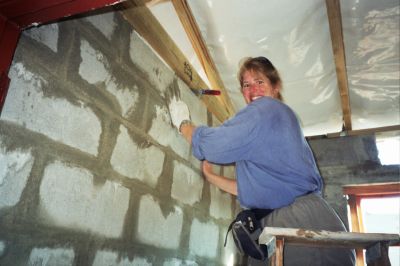
Donna Bagging the walls |
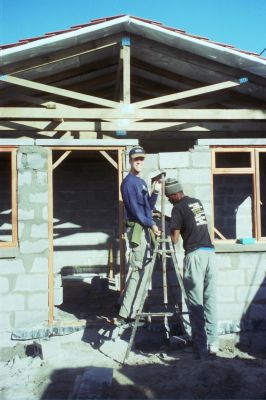
Kirk helped out too |
We got up early, got on our dirtiest clothes to work in, had breakfast, and dashed out to wait for Sarah to pick us up. We chatted with her all the way out to Khayelitsha, where we would be joining a
Habitat for Humanity international student blitz build. They were building 15 homes in one week with 200 international students! This was our first time to head into a township. It was still dark as we were arriving. As we got closer, we could see dark shapes of people, lots of people, huddled by the road side, waiting for rides. At times we were afraid we might accidently hit someone as they darted across the road. Then we pulled up to an intersection and the first "structures" came into view. There were thousands and thousands of shacks built right next to one another. They seemed to be built from whatever material the owners could find. Lots of corrugated tin, flattened metal boxes, random pieces of plywood, etc. They looked like a stiff breeze could knock down the whole lot. Donna asked Sarah, "Do people live there?" Sarah said, "Yes they do. Now you see why we are needed out here." Most of the structures were positively tiny.
The questions started flooding out now. How many people live in one? Do they own the land? Does the government tear them down? How does Habitat come in, and decide who to build for? Sarah answered as best as she could. She had questions for Donna as well about the Habitat projects she had worked on in Georgia.
We arrived at the site around 7:15 AM. People were flooding into a common room. It was full of students. They had breakfast and coffee/tea available. Since we had already eaten, Donna stood in line, for the tea. It took a LONG time to get through the line. I got us seats in the front row. Sarah was giving the devotional this morning. It was very poignant. It turns out that two of her friends had had family members hijacked in the last year, and then her family had been robbed just this year. She was quite affected by all the violence going on in South Africa. It made her angry and actually made her want to take a step back from Habitat. Why is she building houses for people who are committing crimes against her and her family and friends? Then someone shared with her that she's actually doing the work for God. Okay, yeah, but that's not good enough. She knew it should be, but it just wasn't. Then a father of one of the friends shared his story. He had been hijacked. He knew they were going to kill him. They were driving him out somewhere to dispose of him. So he started to talk to them about God. Did they know where they were going to go? Did they know God? In that short period of time, they developed a "relationship", a "connection" with him. They dropped him off and apologized to him. They couldn't kill him once they had made a connection with him. Sarah then realized that in doing Habitat, she's building, not just houses, but relationships. Connections with the black and colored comunity. It's a start. It has to start somewhere. She encouraged all South Africans (especially) to do the same.
After the devotional, we were sent off to our assigned houses. Donna and I were assigned to house 12. They were short-handed and needed some help. We walked to the house, one of the furthest ones away, and passed many others along the way. They were much further along than ours was.
The houses they build here are cinder block houses. They lay a cement slab, and then raise the block walls with mortar and cement blocks like bricks. At the habitat homes, Donna worked on in Georgia, they were all wood houses, so this was new to us! The front wall of our house was 1/3 complete, so that was what we all worked on first. Each site has 2-3 professional builders and about 17 untrained volunteers. The builders were black South Africans and didn't speak much English. They would ask for the tools or cement or whatever they needed in their native language,
Xhosa . Eventually we learned what they meant. For example, "daga" means "cement". Donna was a bit limited in what she could do due to her bad back, but she always kept busy. She did a lot of filling in of holes. When the walls go up there are often gaps between blocks that need to be filled in with mortar. She got a trowel and did that. It is called "bagging" here. Also when they needed more cement, she helped with that too. She couldn't carry a whole shovel full, but she did carry it one trowel-full at a time. One of the interior walls was terribly bowed, and out of place by about 3 inches. We tore it down, and they put it back up in the right place. As the front wall went up we put in the front window frames at the same time. They were locked in place with nails that go into the frame whose heads are between two block layers. I helped make cement, bring it to wherever it was needed, helped the builders make the walls straight, bagged some of the walls. Later I helped tear down the interior wall, and helped hang the front door and the kitchen door.
Donna went outside and helped build a fence with some of the other girls. There, she met Julia the owner of the house. She had a tiny baby on her back. His name in
Xhosa means "Beautiful". Her husband is in the armed forces and is on deployment. He is in Botswana and won't be back until September. Their baby is only 2 months old, and he
is beautiful!
While I was helping hang the doors, I learned some of the tricks of the trade. The builder didn't have the right drill for the screws, so he used one of the large nails. It worked ok, but took a lot more pressure, and mostly burned the hole in. Also, when they put the wood screws in the hinges, they would hammer them in most of the way and then screw them the final few turns. I was surprised that they weren't using very secure methods on the doors. The screws were way too short (1.5 inches) and the locks were very cheesy; they are easy to pick. On the way home, I suggested these and other improvements to Grant.
Next was lunch time! It was called "Sem". It was some sort of beans, white lentils maybe, covered with a red sauce, and served with a sausage. It was very good! Donna couldn't eat it all there was so much.
After lunch, Donna didn't have much to do at the site, so she went for a walk with two girls from one of the universities at Durban (South Africa). They were getting something from their friend on another site. As they were walking, a little boy, about 3 or 4, walked up to her and grabbed her hand. She squatted down and said "Molo" (hello). He answered and said "Eweh"! Ack! She didn't know what that meant or what to do next! It turns out "Eweh" is just the response to "Molo". He was a sweetie.
The other house was MUCH further along than our house! Of course they hadn't had to take down any walls. They stayed for about five minutes and on the way back many people greeted them along the way. The kids were Donna's favorite.
Back at the site, there was another little boy who was about 6 or 7. She said "Mollo", he said "Eweh". That was of course, her limit. She asked someone what to say next, but he was ignoring, "How are you?". Finally she just reached over and tickled him. THAT sure got his attention! He wouldn't leave her alone for the rest of the day! Everywhere she went, he followed, trying to get her attention. He'd shout, yell, make any noise to get her to turn around and look at him. At one point she was ferrying daga (cement) back and forth and he yelled. She raised her gloved hand, covered with cement and pretended that she'd come after him with a "monster hand". After that, whenever he saw her he'd raise both hands and crook them at her, teasing her! He was great!
Donna spent the rest of the afternoon bagging the walls and around the window frames. I helped the builders hang the front door and the kitchen door. The kitchen door was a two-piece type. At around 4:40, we had to leave with the students. We were supposed to leave at 4:30. The students were a bit frantic, but as we were walking back to the community center we saw that lots of other house teams were leaving now too. We found Grant and he gave us a ride. On the way out, he stopped at the student's bus and told the driver to wait until all the students were aboard and to send someone around to all the house sites to make sure everyone got on board. Apparently one time last week, the bus left before all teams were on board and two house teams got left behind!
On the way out, two men flagged our truck down and they hopped in the back. Grant dropped them off near the freeway which was apparently a bus stop. We then dropped the plumber off. He lived in a shack on top of one of the hills nearby. We chatted with Grant on the way back, and he dropped us off right near our hostel.
When we got back we decided to go to Movie Monday at the theater. They have a deal with the
Spur restaurant there where for 50 rand you get two burgers, fries, and sodas and two movie tickets. That is the same cost as the two tickets themselves! The burgers were good and we got cheese sauce on them for an extra 8 rand. Donna was disappointed at the lack of ketchup. After dinner, we saw "
The Life of David Gale" with Kevin Spacey. It was good!
Tuesday, July 1, 2003, Cape Town/Robben Island:
We got up around 8AM and had a quick breakfast and called a rikki. Simon, the same driver who drove us to and from the waterfront on Sunday, picked us up again! We had him drop us off at the Clocktower.
The deal we got on the tickets to Robben Island is quite a good one! Tickets are normally 150 rand per person. We got tickets for 60 rand per person! They are currently running a special on all of their 9AM tours. The entrance area where you wait to load the boats is right in the
Nelson Mandela Gateway (where we bought the tickets). They have all sorts of information there about Robben Island and
Nelson Mandela, so we browsed around while we waited for the boat to begin boarding. During the thirty minute crossing to Robben Island on the boat, we watched a video, first about safety aboard the boat, then about the history of Robben Island.
When we first arrived on Robben Island, we were ushered onto a bus for the first part of the tour. We spent the next 45 minutes touring the island by bus. This part of the tour was truly too quick and we really didn't get to see much, as we didn't leave the bus and it was virtually impossible to take photographs or get to see much as we quickly drove past the many sights and sites that were being described. One site we visited was the Lime Quarry, where the political prisons were forced to work for 13 years. Many of those prisoners as a result of not being allowed to use sunglasses or have any other sort of eye care, now have serious eye problems. Nelson Mandela recently had cataract surgery and won't allow flash photography when people take his picture. There is a hole at the quarry (a cave of sorts) where the men were told to eat, and also to use the toilet. They had to dig holes to use the toilet, using their hands. The problem was, sometimes, they'd accidentally dig where someone else had already gone. They would not be given anything to clean themselves with and there was no water. They then had to eat their meals with their soiled hands.
We also drove by the leper cemetery and the male leper church. One interesting thing about the leper colony is that it was segregated not only by race, but also by gender. And yet, there were still 17 pregnancies there. Every one of those children was born "clean"...without leprosy. Sadly, as a result, the children were then taken from their parents at birth and placed in orphanages, never to know their parents.
We saw the 19th century lighthouse (from a distance), the 2nd World War gun fortifications and gun emplacements -- that were completed 2 years AFTER World War II was over, a shipwreck in which everyone (including the cargo) was rescued, a Cape Gothic-style Garrison church built in the early 1800s (and the oldest existing building on the island). We also saw the rare bontebok and the endangered African black oystercatcher.
We drove by the prison house of Robert Sobukwe. Surprisingly, many people in South Africa haven't heard of
Robert Sobukwe, who founded the
PAC and called for nationwide demonstrations against the pass laws. He told people to burn their pass cards and turn turn themselves in to the police stations in non-violent protest for arrest. The police station at Sharpeville was completely mobbed and the police opened fire, killing 69 people and wounding 160. Soon after, the PAC and
ANC were banned and security forces were given the right to detain people indefinitely without trial. Robert Sobukwe was tried and sentenced to three years in prison, which he served. But when he was due to be released, those in government were afraid to release him and a special sesson of parliament was called to address what to do. A special statute was passed called the "Sobukwe Clause" allowing them to detain Sobukwe on the island. He was kept completely isolated from other political prisoners and the government reviewed his case annually, deciding whether to keep him or release him.

Robben Island Prison |
Finally, we went to the maximum security prison, where the political prisoners were kept. There was also a separate prison nearby for convicts -- they were treated with a higher status than political prisoners, and we did not visit that prison. We were dropped off out front of the prison, where we waited for our guide. All the guides at the prison are ex-political prisoners. Ours had been incarcerated in 1985 and was supposed to serve a 13-year sentence. Luckily, he didn't have to do that. But he was somewhat distressed to still be spending time there, even though he was now the person with the keys. He had a very dry sense of humor, but never really smiled. He told us that he was locking us in the prison and he wasn't going to let us out unless he was happy; the only way he'd be happy was if we asked a lot of questions. We had a school group with us, so we figured that would be no problem -- I wondered if he cared about the QUALITY of the questions!
The tour was really interesting, because we got the perspective of someone who had BEEN there -- through the whole thing. For example, there was a doctor who would come only one day a week (Mondays) for 2 hours. If you needed something, you tried to see him then. But if you didn't get in to see him, well, tough luck until next week. If you didn't get to see him, you sure didn't want to have to ask the guards for anything! If you asked for painkillers, they wouldn't give them to you! They'd give you laxatives, instead! So, eventually, the prisoners figured it all out. If you asked for laxatives, they'd give you painkillers. They'd start asking for the opposite of what they needed. Donna asked the guide how many prisoners were in the prison when he was there -- between 1800 and 2500! One medical doctor for 2 hours a week! That's nuts!
We went and looked at the sleeping areas. It was a common room, not particularly large, about 15 feet by 30 feet. Our guide told us that originally, the political prisoners incarcerated at Robben Island were given short-sleeved jerseys, short pants and sandals to wear year-round. That's what they ate, worked and slept in. For sleeping, they had two relatively think pads that they placed on the floor and two blankets -- that's it. In the single room we were in, 150 men slept there! They must have been wall-to-wall! Eventually, the political prisonsers started getting conditions changed by going on hunger strikes in the prison. It took a while and happened a little at a time, but they did eventually get things changed. For instance, they eventually got long pants, jerseys and jackets.
There was an interesting thing that developed a result of being in this prison. There were many educated men incarcerated at Robben Island. But there were also many who had not yet received an education. The men at Robben Island set up a system whereby each man would educate another. Everyone who wanted it, would receive an education. Many, many men walked out of Robben Island with degrees -- some of them quite advanced degrees. Some hadn't even been able to read when they were first incarcerated. And all this happened under the noses of guards and wardens who had forbidden the education of the prisoners.
The prisoners were also not allowed to make music or sing. Yet one of the prisoners made a homemade saxophone from driftwood that he and some of the other prisoners were able to collect. When he was discovered one day, the warden was shocked and yelled, "You can't have made this! You're not smart enough! You're BLACK!" The prisoner later said that he would have normally beat the warden for saying such a thing, but his first priority was to protect the saxophone, which somehow they managed to save!
Next, we headed over to see Section B, which was primarily an isolation ward. Many of the leaders of different groups and factions were kept here to keep them isolated from the main prison population. Nelson Mandela spent most of him time in this
section , for example.
The tour was over all too quickly. We actually ended a few minutes after 12, and our ferry back to the mainland was due to leave AT 12! We rushed back to the dock and boarded quickly. We didn't even have time to check out the penguin habitat along the way! Oh well. We played "Palace" on the boat on the way back. At the Waterfront, we went back to the Tourist Information office and booked some accommodation at Kruger Park. I'm glad we went when we did -- it's school holidays and it's booking up fast!
We came back to the hostel and made lunch. Then Donna wrote in her journal for a while and I went to the bookstores to get quotes on selling some of our old guidebooks back. We had dinner and after dinner we went and did internet. Thomas said he'd buy our Southeast Asia guide from us for 50 rand. Cool! And when we got back from internet, he had decided to pay us 80! He said he thought that was a more fair price! That was very generous of him! We stayed in the lounge and talked with him for a good while. He's about to head to Singapore and try to buy a bicycle to replace the one that was stolen from him a few days ago (here in Africa).
Wednesday, July 2, 2003, Cape Town, South Africa:
We had a very lazy day today! The best kind, actually. We got up late had breakfast and then Donna worked on catching up her journal. We spent some time working on the internet and then had a late lunch. Donna had run her journal out and needed a new book, so we went looking for one. We found one that looked pretty good and it had a cardboard cover, which means she gets to cover the outside with pictures, too, so we bought it.
We spent the afternoon lazing around too. I read for a while, while Donna worked on her new journal. We chatted with Thomas and some other folks from the hostel some more. We checked on our Egyptian visa and have decided to get it on arrival instead of getting it in advance. It looks like it will be less expensive to get it on arrival, which is unusual. We also made arrangements to go back to Habitat tomorrow. After another dinner and some more chatting, we had some sleep! (Aren't we exciting?!)
Thursday, July 3, 2003, Cape Town & KTC, South Africa:
(by Donna)
We went back to
Habitat for Humanity today. We got up early this morning because we had to run errands first. We did our grocery shopping and other errands and then headed to the train station. Along the way, we stopped and sold our India book back for 35 rand. We arrived at the train station and bought a ticket to Observatory Station, where Grant had said he'd pick us up at 11. The train was due to leave at 10:25. We weren't sure how long it would take to get there, but the guy at our hostel had said around 15 minutes, so we figured we'd be there in plenty of time. Ha! We got there in 5 minutes! We were WAY early. We saw a dalmation and a great dane there when we got off the train and we tried to pet them. The dalmation was friendly but the great dane was quite stand-offish. As we walked away to find a place to sit and wait for Grant, I realized I had left my wool hat on the train! Drat! Oh well, Kirk reminded me that some other person is going to have a warm head now and that encouraged me!
Grant came and got us a few minutes after 11. He was parked at the other side of the platform. He'd also picked up an Irish girl, Liz, who had arrived from Ireland just the day before. Then, we headed to the airport. A new regional director has just been appointed and he was flying into Cape Town to get the feel of things. We were going to pick him up on the way to the site. He flew in from Durban and had a rather rough flight, apparently. And although, technically, the temperature in Durban is the same as in Cape Town, Cape Town is much colder, he said.
We chatted on the way to KTC. Interestingly, although the town is called KTC, no one, including the locals, knows what "KTC" stands for! We were right near the border of KTC and Nyanga. There were three houses being started today, basically we had to dig ditches along the outer walls of each house so they could pour concrete for the foundations. In other words, this was not really work that would be easy for me to participate in with my back. There wasn't anything ELSE to do, and I'm not out here just to sit around.
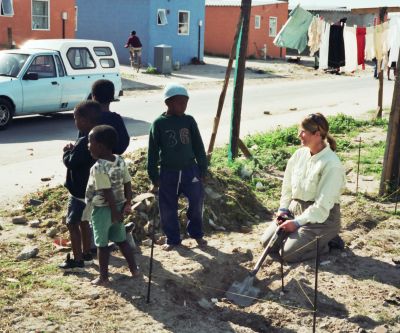
Donna and the kids |

The Kids Digging |

Cape Flats Area |
When we first arrived, we were at one site and Constance came by and introduced herself. This was to be her house. She was excited! She had been terribly nervous the night before, she told me! they were just in the process of staking the site, so we were sent over to another site where they were already digging
The ground was pretty hard. They staked out lines to show where the trenches had to be dug. They were supposed to be sixty centimeters deep. So, I SAT in the ditch with my back straight and started shoveling little scoopfuls of dirt out of the ditch. It wasn't much and it took longer than everyone else to do the same work, but at least I was making a contribution. I don't know how the others saw it -- whether as a help or a waste of a perfectly good shovel, but was there to help and that's what I tried to do! If someone came and took the shovel away, I always gave it up (unless it was one of the children). But if I saw a shovel laying around unused, I always claimed it and got back to work.
Even SITTING in the trench, it was hard work. I quickly got, burst and tore a blister (all before I even realized I had one). Kirk worked his butt off. He alternated between swinging the pickax and using the shovel. The ground was so hard and full of rocks and garbage, you had to break it up first by using a pickax before you could really accomplish much with a shovel.
After we finished the first site and headed to the second, I found out that the first site had been Edison's. Edison is one of the men working with us. I had watched him literally ATTACK the dirt on the first site. He was truly an animal! When I found out the first site had been his house, I congratulated him and wrongly assumed his enthusiasm/vehemence had been due to the fact that it had been his house. But in fact, at EVERY house, he was energetic and forceful behind the shovel and pickax. He clearly wants all of these houses built in his community. I was impressed with him and quite proud of his work ethic.
Although there were kids around on the site on Monday, today was different. Today, many of the kids helped. First of all, we had a much smaller crew today and most of them were local. At the second site, about three kids had followed us from the first site, watching us work. One little boy (about 4 or 5 years old) was so cute! Every time I stood up, he dusted me off, trying to get the dirt off my clothes. A bit later, a few more kids came by. They were standing around in a semi-circle, asking me questions. All of the sudden, a man across the street comes out and starts yelling at them in
Xhosa (a local African language). Their eyes all got wide and they scattered. All of the men on the site were cracking up. I found out later that he yelled at them to leave us alone, because we are working. The men on the site were laughing because HE wouldn't come and help, but he ran all the kids off!
There were still several kids working at the site at that point. One of the men there was related somehow to someone getting a house, so his kids (or at least several kids) were with him. They were cute, but we often had to fight them for our shovels. After a while, the little kids came back and we were mobbed with children. There must have been about 10 children at the site with us, helping in some way, either pulling rocks or rubbish out of the trench or digging, or watching. Or, of course, taking turns dusting me off any time I stood up.
We were almost finished at that site, but not quite, when the site manager sent me, Kirk and Liz over to the last site with Edison and another man to get started digging. Some of the older children followed us over. I was getting a bit worried about Kirk at that point. We had been digging for quite a while and he'd been munching on Horlicks cookies (from our India stash) all along. But, he seemed to be sugar-crashing, big-time. It was getting pretty late and we hadn't had lunch yet (it was well after 2pm). As we walked over to the third site, we did seem them heading toward us with food, but they went into a house and we started digging. I told Kirk to eat some more. A few minutes later (although it seemed like an eternity), some ladies came outside with tea and coffee. We stopped for a bit. Then, out came some sandwiches. We weren't too sure what was on the sandwiches, but we wolfed them down anyway. It was some sort of pink thing -- meat maybe, with butter.
While we were eating, the children all went to town! They were THRILLED to get the chance to "play" with the shovels without competing with the adults! We watched with a certain degree of amusement (and relief, not to be working for a few minutes).
After lunch, Edison showed me to a toilet. We were working in an area primarily of government housing. All the houses had been built by the government -- they were small box houses. I saw the inside of one when I went in to use the toilet. It was a single room, with one area walled in as the toilet. It was very basic. The houses we are building are far more advanced and luxurious in comparison! I also got a chance to see one of the little boys that had been hanging out with me early on. He lived in the box house where I used the toilet and had been called home for supper. I said hello and thanks to his parents and then made my way back to our third and final site for the day.
Edison had told Kirk they don't want us to be at the site after 3:30. We're not sure why; perhaps it's a safety issue. Nonetheless, by 3:30, they plan to take us to the taxi stand where we'll catch our shared ride back to City Bowl.
Another woman who will be living in this house came over to the site to help. Kirk and I had a chance to chat with her for a while. She has lived in a shelter in this township for 22 years! She's been on a waiting list for a house for ages. In order for someone to qualify for a Habitat house, they have to own the property the house will be built on. They also pay property taxes to the South African government. The taxes are based on what people can afford. In this case they are around 20 rand a year. They pay them on a monthly basis, since they probably could never come up with 20 rand all at once to pay it to the government.
Around 3:15, Constance and another woman came to the site with 3 MORE plates of food - this time it was HOT food (a chicken leg, potatoes, rice, gravy, carrots). They came straight up to me, Kirk and Liz and handed the plates to us. It was food for the foreigners on the site, specially prepared African dishes. I was actually hungry again already, so I took it happily, as did Kirk. Liz was reluctant, but we convinced her to take it anyway. It turned out she was a vegetarian (oops)! Edison told us we would leave as soon as we were finished eating.It would be a short day for us, that's for sure. Short, but full of hard work!
When we had finished, Edison and the site manager walked us to the minibus station, where we caught a minibus to Cape Town for 5 rand each. The trip back was quite fast. We parted with Liz at the train station. She was staying at a hostel near the Waterfront. We headed back toward the Company Gardens. Along the way, we bought a new hat for me from a vendor on the street. It's a very dark navy blue fleece and it's nice and warm!
Back in the hostel, we rested for a bit and I updated my journal for a while. Then, we went to check the internet. We have discovered that
King's Harbor Church has started putting our pastor's sermons online now and we burned our first CD of one of his sermons! Then we went back to the room and listened to it! It was sooooo cool to be able to hear one of the sermons from home!! It was almost like being there!
Friday, July 4, 2003, Cape Town, South Africa:
Happy American Independence Day!
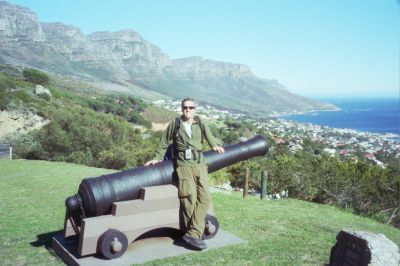
Kirk at Kloof's Nek Cannons
|
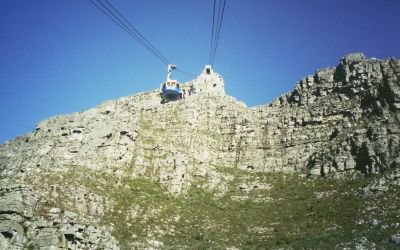
Table Mountain Cable Car
|
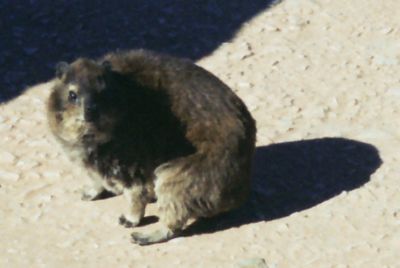
Dassie
|
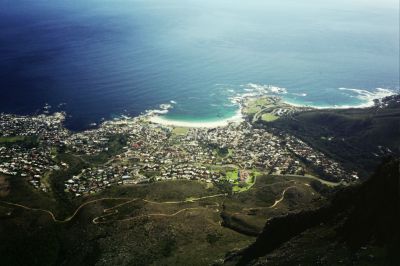
Camps Bay
|
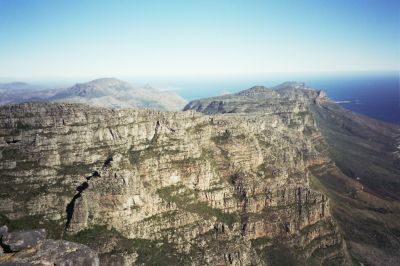
12 Apostles
|
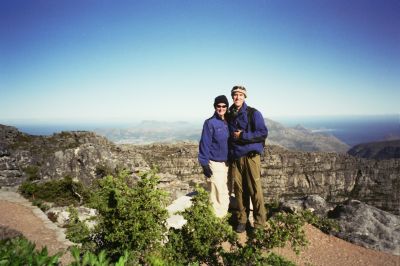
Us at Cape Point
|
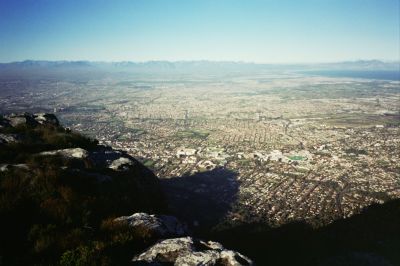
Cape Flats from Table Mountain
|
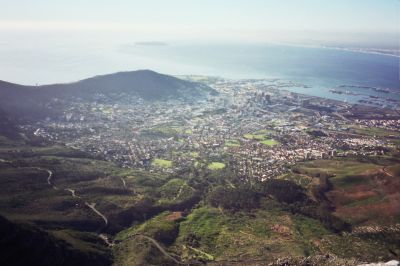
City Bowl area of Cape Town where we stayed
|
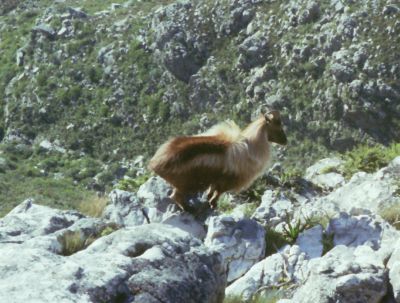
Mountain Goat
|
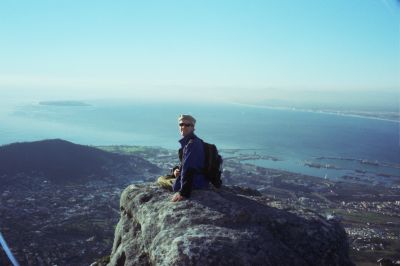
Kirk on the cliff
|

Lion's Head
|
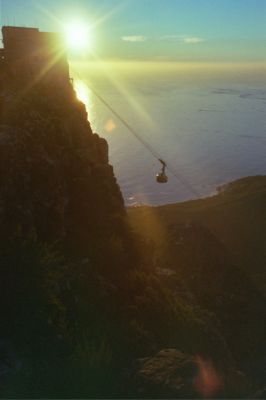
Sunset
|
Today we decided to head up
Table Mountain. We woke up late since we were tired from the night before. Donna listened to Chris's Sermon again from the night before while I took a shower. We had a leisurely breakfast, played cards and such, and then after lunch, we headed out. We decided to walk up to the lower cable car station from our hostel. It was about 3 km away. When we got up to Kloof Nek, the pass between Table Mountain and Lions Head, we went on a bit further to the look out point over Camps Bay. They had some old cannons there. It was a great view, and we took a few pictures. Then it was on up to the lower cable car station. We followed the road for a while, and then I spotted a short cut. Donna was a bit wary about it, but she followed me up the path. More like stair steps. When we got to the cableway, I asked if she was up for climbing Table Mountain (there are over 300 routes up). She said she wasn't feeling well, a little sore throat, so we would take the cable car up and down. The tickets were 75 rand each for a return ticket. The
Table Mountain Aerial Cableway was originally built in 1929. Now they have the rotating cable cars similar to the Palms Springs tramway back home. The ride up was quick and the views were stunning.
When we got to the top, we went out and started looking at the magnificent views. It was great! Almost immediately we saw one of the local mammals. It was a
dassie or rock hyrax. It looks kinda like a badger. They are most closely related to the elephant of all things! It turns out it is the local scavenger. It begs for food, and goes through the garbage cans. Unfortunately the cans aren't dassie-proof. They have been known to bite too, so we kept our distance.
Next we went on a walk around the top of Table Mountain. Near the upper cableway station they have a nice interpretive walk with lots of educational signs teaching you something or pointing out the sights in the distance. Eventually we went off the interpretive trail and onto the more rustic trail that goes all the way to the other end of the top of Table Mountain and back. It was about a 3 km walk over rough stone. We took our time and stopped at lots of sights along the way. We went all the way to Maclears Beacon, the highest point (1086 meters). The views were fabulous. We saw Cape Flats, the City Bowl, and we were even able to pick out our hostel with our binoculars! We took our time, and we stayed until the last car down the mountain at 6:00 PM. It was a great time! Since it was cold and getting dark, we decided to take a rikki back to our hostel.
We had a wonderful dinner. Donna mixed mushroom sauce with ground beef and served it over potatoes. After dinner we went to the
Labia theater again and saw "
Charlies Angels: Full Throttle" VERY FUNNY! It was like a live-action cartoon!
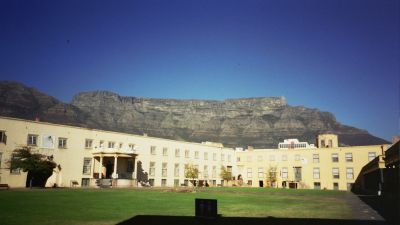
The Castle of Good Hope with Table Mountain in the Background
|
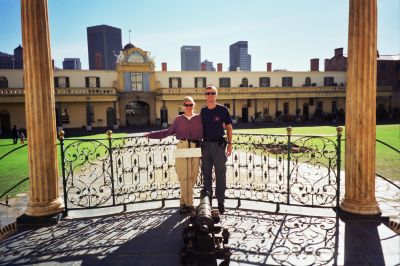
Us at Castle of Good Hope |
Saturday, July 5, 2003, Cape Town, South Africa:
We decided to go see the Castle of Good Hope today. After breakfast, we walked down through the city center and stopped at the tourist information center on the way. We tried to book more accommodation for our stay at Kruger Park. We have reservations for the 13th, 14th, and 16th. We tried to get more accommodation on the 11th, 12th and 15th but had no luck. We will go anyway and try to get cancellations or if that fails, we will just stay somewhere outside of the park. It is school holidays now so things are all booked up in the park.
Next, it was on to the castle. The "
Castle of Good Hope" was built in the 17th century. It was built by the "Company" the Dutch East India Company, and is currently the oldest building in all of South Africa! In 1795, when the British invaded, they took it over. It is a large pentagonal structure. It still serves some military purposes, but seems mostly devoted to tourism now. It cost us 18 rand each for admission, and the guided tours are included in the admission price. There are four museums to look at, too. We got there around 11:15AM and went in to the Military Museum while we waited for the Noon tour. The museum was pretty good, with lots of armament and explanations of the various battles in the area.
At Noon, we met the guide and took the tour around the castle. He doesn't bring you to the museums, so you can do that on your own at your own pace. The guide was pretty good, and funny at times. We saw the dolphin pool, some of the dungeons where they would torture the prisoners, the battlements, and other places in the castle.
After the tour, we went through the rest of the museums. The governor's house and vice governor's house were particularly good. They had lots of period furniture and good explanations. Upstairs in the governor's house was the table that can seat 100 people! It isn't one single piece, but it is very impressive. I like stinkwood. The furniture made from it is very beautiful!
On the way back from the castle, we stopped at
Wimpy's for lunch. It is a burger chain that I had wanted to try, and Donna went along with it. The burgers were ok, very processed. Nothing like
In-n-Out! I am looking forward to that when we get home!
After we got back to the hostel, I worked on this post at the internet shop, while Donna washed our clothes at the laundromat. It is nice to have machine-washed clean clothes again! I burned many more of our church's sermons so we can listen to them on our CD player. Dinner was spaghetti. Very good! After dinner, we worked on the net some more, and then went to bed.
Cape Town to Kruger Park
Sunday, July 6, 2003, Cape Town, South Africa:
Today was a lazy day. Donna didn't feel well, so we got up a little late. Rick picked some of the oranges in the tree at the hostel for us, so we had fresh squeezed orange juice for breakfast! Unfortunately, later in the day, we figured that it was probably that orange juice that made Donna a bit sicker. After breakfast, she went back to bed while I went down to the internet cafe and worked on the last post. I also looked into the car rental options. We want to rent a car for a day and go see Cape Point before we leave Cape Town.
That evening, Michael picked us up and brought us to church again. We went to
Claremont Methodist Church, where they were starting a series in Romans. It is always great to attend a church of believers! The worship was great again, too, with lots of songs we knew from home. After church everyone had plans, so Michael just brought us back to the hostel. It was probably for the best, since Donna still wasn't feeling 100%.
Monday, July 7, 2003, Cape Town, South Africa:
We woke up to a very cloudy day today. Since it was so cloudy, we decided to postpone our car rental and drive until the next day. So, we decided to run several errands that we had to do and and see a museum. We started with a quick email check, and then we were off to the train station to book our tickets back to Pretoria. Unfortunately, they didn't have any space available on any train to Pretoria until July 17th! It was school holidays, and all the trains were booked up! Bummer! We would have to take an overnight bus. We were able to get tickets on the Intercape bus lines for Wednesday night. The cost of the bus tickets was nearly the same as we paid for the FIRST CLASS train tickets from Jo'burg to Cape Town (800 Rand for two)! Oh well. The bus ride was going to be 21 hours.
After that, we headed to Greenmarket Square where Donna bought her one South Africa souvenier. She bought a wooden giraffe statue for 20 rand. She was still feeling tired and didn't want to bargain any harder than that. Then, we headed back to the hostel for a lunch of grilled cheese sandwiches.
After lunch we headed to the
South African Museum. It was a short walk to from our hostel. We got there around 3, and had about 2 hours to view it. It was started in 1825, making it the oldest museum in South Africa. It is geared towards Natural History and Cultural Diversity. It is a bit disorganized, and looks like they are in the process of improving many of the exhibits. It has an amazing amount of stuffed animals of all varieties. All of the big game animals are represented here in glass cases. I liked the mineral section and the meteorites.
After the museum, we went back to the hostel for a bit, and then headed to the Colorado Spur restaurant for another Monday Movie Madness deal. This time, we got there at 7:00 PM, and boy, was it crowded! We waited in line to get in for quite a while. Finally, we did get in, had our burgers and went off to the theater to see "
Bollywood Hollywood". This is an Indian movie set in Canada. It was funny! It was also interesting to compare it to the other two Indian movies we have seen, "
Monsoon Wedding" and "
Bend It Like Beckham". I would recommend it.
Tuesday, July 8, 2003, Cape Town, South Africa:

Jenny Rae, Kirk and Donna at Breakfast
|
Today it was clear. Since it was our last opportunity to get the car rental, we rented the car. It was tough to get Donna out of bed. She was very sleepy, and hadn't slept well last night. While I showered, she went back to sleep, and when the guy came with the car, I went to take care of the paperwork, while she got ready. When I got back with the car, we headed to Jenny Rae's place as she offered to make us breakfast. With little trouble, we were able to find her place. She served us a wonderful huge breakfast! It was great! We had a good time chatting with her about her plans for the future. After breakfast, we brought her over to Michael's work, and they gave us directions and suggestions for our trip to Cape Point.
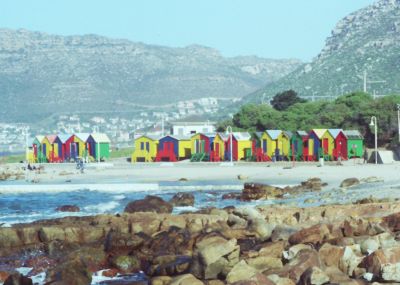
Colorful Beach Bungalows
|
At around 11:00 AM, we were on the road to Cape Point. The plan was to go down the Eastern side of the cape, to the point, and then back around the Western side to Cape Town so we could see the sunset on the way back. We found the freeway easily and headed South to St. James Bay. There are many lines of colorful beach bungalows here. Then it was through Fish Hoeck, Jagger's Walk, etc, on to Simon's Town. Simon's Town has a fairly large harbor. The views and terrain here are very much like California's Central Coast. We continued South to the park entrance.
At the entrance of
Cape Peninsula National Park, we were pleasantly surprised that the entrance fee was only 25 rand each (we had heard the fees were 35 rand per person). We headed in and decided to go to Cape Point (the furthest point South) first, and then work our way back North and out of the park.
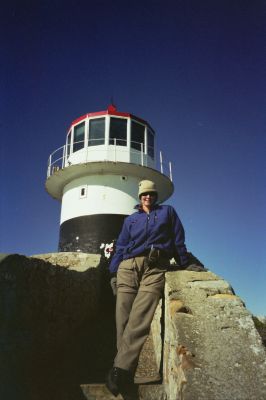
Donna at the Light House
|
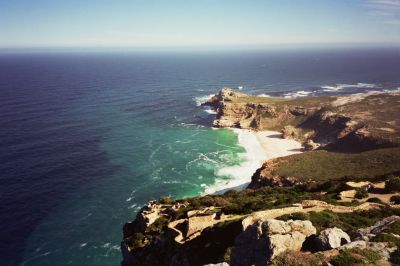
View Looking North from the Light House |
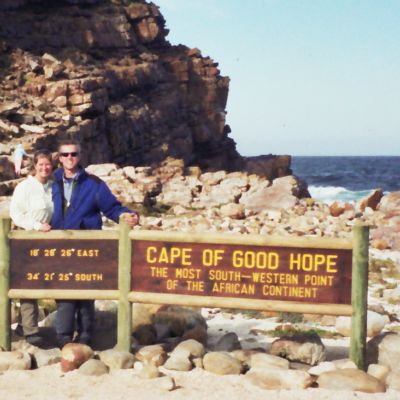
Kirk and Donna at Cape of Good Hope
|
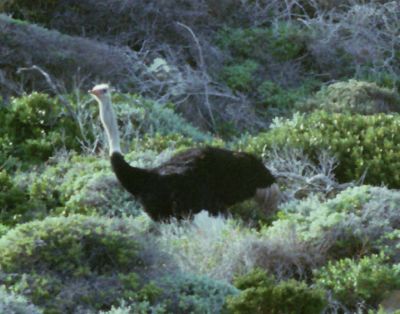
Ostrich
|
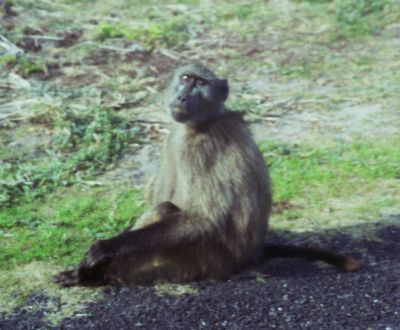
Baboon
|
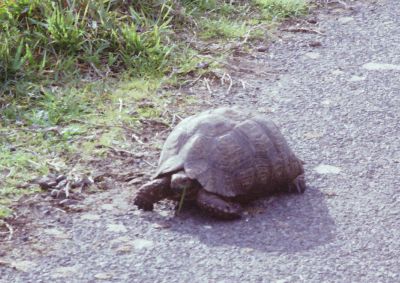
Tortoise
|

Bontebok
|
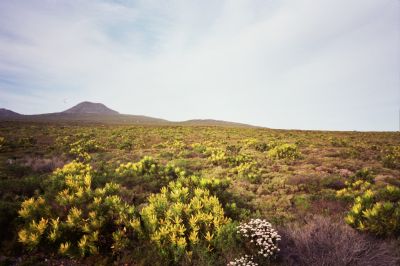
Cape Point Fields
|
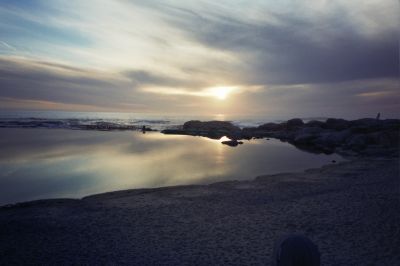
Sunset at a Pool
|

Sunset at Sea Point
|
There are two lighthouses at Cape Point. The original one is on top of the point, several hundred meters above the water. It is no longer in use, since it was so high up that it often was shrouded in clouds and fog. They installed another one down closer to the water. The tourists, though, still go up to the original lighthouse as it has the best view. We walked up the hill to the lighthouse and saw a little striped mouse cross our path on the way up. Our first animal of the park! They have recently installed a funicular for which you can pay 20 rand if you don't want to walk up the path. When we headed down the path to the car park, we picked up some sodas and had lunch in our car before heading out to see the rest of the park.
After lunch, we stopped at Rooikrans where we saw baboons. When we passed them, we rolled up the windows. They are supposed to be pretty aggressive here. We went on to Neptune's Dairy, where we saw a herd of antelopes, and several ostriches. We continued driving on each and every road we could in the entire park. At one point we saw a very large tortoise. We had a great time! We left the park shortly before closing. We then headed Northwest as close to the coast as we could; however, since the road was closed at Chapman's Peak, we had to go around to the East and then back again to get through to Hout's Bay. Hout's Bay has a famous surf spot called "Dungeon's". It is one of the big wave locations in South Africa. Donna navigated us to where she thought it was, but it wasn't a good day today. Very flat! Oh well. We headed on up the coast to Camp's Bay which is a very nice little beach town. The sun was going down and we were in for a very nice sunset! The next stop was Sea Point. We stopped by the beach there and watched the final plunge of the sun into the sea. Beautiful! Sea Point looks a lot like Santa Monica. Finally, we pulled into the hostel after dark and made dinner and packed. We were heading to Pretoria tomorrow!

Some of the Apartheid Laws |
Wednesday, July 9, 2003, Cape Town, South Africa:
We got up early today, had breakfast, and officially checked out. We put our gear in a storeroom while we went out for the day. Our first stop was to return the car. Then, we walked to the
Parliament for our tour. We got there a bit early and had the opportunity to read their history display in the Visitor's Lounge. The tour was great! We had a wonderful tour guide who had lots of anecdotes, and was very interactive with questions and answers. First, we went to the
NCOP (National Council of Provinces) Assembly Room. It is in the oldest portion of the parliament building. The hall is very nice and the seating area was recently renovated. Each delegate has a computer screen that holds all the information they need, so they have very little paper useage. The NCOP is similar to the US Senate in that each province has an equal number of seats.
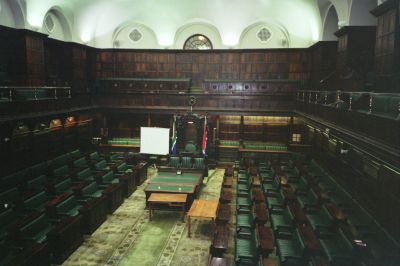
Old Assembly Hall |
Our next stop was the old assembly hall. It is no longer used by the current government for official uses because this is where all the old apartheid laws were made. They still use it for conferences and and other meetings.
The final stop was the National Assembly. The nearest thing in US government is the House of Representatives. They have a no-photo policy in this room for security reasons. There are no computer screens here yet. They are going to be getting more translators soon though. Currently everything is translated in English and Afrikaans, but soon they will translate everything into 6 languages. There are 11 official languages in South Africa! We also learned that the employment rate in South Africa is 33%! That's the EMPLOYMENT rate, not the unemployment rate! The citizens now have direct access to their politicians now, this was not the case under apartheid, and it is taking a long time for the people to understand this. Our tour lasted 1 hour and 40 minutes. It was very good and informative!
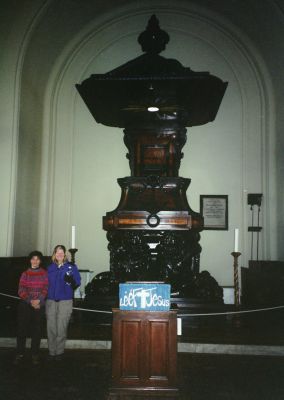
Pulpit of Groote Kerk Church |
After the tour,we decided to stop in at the Groote Kerk Church which we had missed previously. It was nice! It has the largest single span building in South Africa. The pulpit and organ were HUGE!

The Police were Ready |
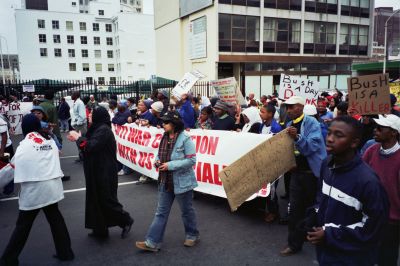
Protesters |
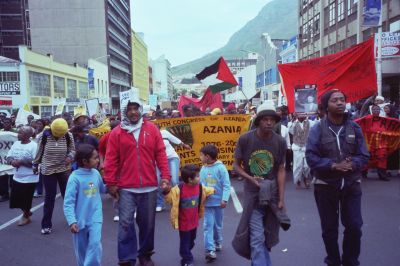
More Protesters |
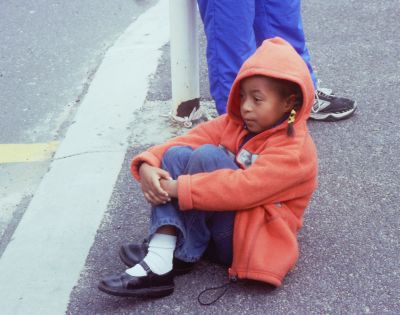
An Observer |
Next we we wanted to go see the protest that was planned. They were going to protest President Bush who was in Pretoria today. It was supposed to be an Anti-War, Anti-Bush protest. After a bit of misdirection, we found that the protest was going to happen right in front of Parliament! We went there and waited. They were marching from the District 6 Museum to Parliament. The police were outside Parliament to make sure nothing got out of hand. They even had an armored vehicle and their riot shields. Eventually, we saw the protesters coming down the street. The police blocked off the traffic so they could come through. When they finally arrived, I could tell, they were a mixed bunch. It seemed like they were protesting all sorts of things. Not just Bush and the war. The group seemed to be made up of several small groups who were not interested in cooperating with each other. Some burned effigies and flags while others told them to stop and be quiet and listen to their speakers. The speakers showed that they weren't really just against Bush and the war, but were really anti-capitalism, pro-communism/socialism. Eventually we got tired of it, and headed back to the hostel.
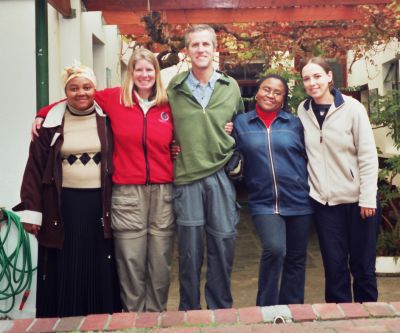
Us and the group from the Hostel |
We relaxed for a while, and around 4:00 called a rikki to come take us to the bus station. We got to the station, and set our packs down at the line. We were right on time -- we were second in line! The bus was a bit late, but it was huge! It was double-decker, with seating on both stories! We got a seat on the top floor three rows back from the front, so we could see the video screen. As the others were loading, I bought us some cooked chicken to snack on for dinner. The ride was pretty good. With a bus this big it tends to be smooth. The movie didn't start until 3 hours after we left the station. It was the live action 101 Dalmations. Pretty good. I had never seen it before. After the movie we tried to get what sleep we could on the bus.
Thursday, July 10, 2003, Pretoria, South Africa:
We did get a few winks of sleep on the bus, but not much! At a stop in the morning, we had meat pies for breakfast, and then it was time for the next movie. Apollo 13 this time. I always like that one! At around 2:30 PM, we finally arrived in Pretoria. Donna's friend from work had arranged for us to stay with one of her coworkers here in Pretoria, Marlene. We called Marlene, and she came by shortly thereafter to pick us up. She brought us back to her work. While Marlene finished up her day's work, we searched for a car to rent for our trip to Kruger Park. We went through the entire list from the phone book, and with a spreadsheet on my visor, we figured out how much each would cost. It turned out we needed one with unlimited kilometers and a low price. We went with SA Car Hire [Tel: +27 12 343-5228, Fax: +27 12 344 0942, PO Box 11029, Hatfield, 0028, Email:
sacarhire@bigfoot.com, Web site:
www.sacarhireonline.co.za Ask for Trix or Ian] They were the second cheapest, but we decided to go with them since they would pick us up for free, and they had a lower excess on the insurance. They were great! I highly recommend them. When we finished with our research, Marlene was ready to go so we headed to her home. There we met Glenn (her husband), and Mia (their daughter), and Max and Tesha (their beautiful rottweillers). They showed us to our room, and we got settled in. Julia, their domestic helper, prepared us a wonderful South African stew for dinner. They are a great family! Marlene and Glenn had gone on a European vacation a while back and while they were in Paris, they were hosted by a very nice family and decided to do the same thing when they got home for anyone they knew that came through town. They even loaned us camping gear so we could camp in Kruger Park! After dinner, we watched the highlights of the Tour De France, and had a wondeful traditional South African dessert called Molva Pudding. That night we piled on the blankets (its cold here!) and slept very well.
Friday, July 11, 2003, Pretoria to Thohoyandou, South Africa:
We woke up early, and had a breakfast and packed our bags. The car rental guy came by around 9:30 to pick us up, a bit late, and brought us to their business to fill out the paperwork. Their business is run out of their home, but that is fine with us. Our car was a 1991 Volkswagen Fox. It is the same shape as a Jetta. It has a nice big trunk so nearly all our gear fit in there out of sight. We returned to the house, loaded up our gear and said our goodbyes to Julia. Next, we had a few errands before getting on the road. We had to find an ATM, some groceries, and a cassette adapter, so we could play our CDs in the car.
It took us a while to do all that and by 1:00 PM, we were officially on the way to Kruger Park. We headed North on the N1 Tollway. And they do mean Tollway! We probably paid around 100 rand just to get to Kruger. Along the way, we stopped at a Wimpy's for lunch, but this time got grilled sandwiches instead of their mega-processed burgers. It was a much better option! In Pietersburg, we stopped at a visitor information station, to get info on camping in the area. This was probably the worst visitor info place I have been in. They had very few brochures, and they were all for the upmarket B&B's and no general info on the region. Oh well, the Lonely Planet had a few in it. We had decided to press on to Thohoyandou and stay at the Acacia campground since we weren't going to make it to Kruger before the gates closed.
When we got to Thohoyandou, we had a bit of trouble finding the campground, there was another campground near where we thought Acacia should be, but it was called Protea. We went on for a distance, and eventually turned around to go to the Protea place. It turns out that Protea campground IS the Acacia campground. They changed their name in May! The camping fee was a bit steep, 95 rand, but we needed a place. We set up our tent, cooked dinner and went to sleep. Marlene and Glenn had loaned us two huge sleeping pads with the gear, and that combined with the sleeping bags and extra blankets made for a very comfortable night's sleep!
Saturday, July 12, 2003, Thohoyandou to Letaba, Kruger Park, South Africa:
We got up at 4:15 AM, and broke camp and drove the 59 km to the Punda Maria gate of Kruger National Park. They open the gates at 6:00 AM. We got there around 5:30 and had breakfast in the car waiting for the gates to open. Once they opened, we went in, paid our fees of 120 Rand per person per day. It is pretty steep, and South Africans get a MUCH cheaper rate, but it is still worth it. We didn't have accommodation booked for tonight, so the guy at the gate suggested we check with one of the rest areas after 7:30 AM for some cancellations.
Stay tuned for the next update when we fill you in on our Kruger Park Adventures. For a taste, we saw 72 different species of animals and birds!
Kruger Park to Pretoria - So Long South Africa!
Saturday, July 12, 2003, Punda Maria Gate to Letaba, Kruger Park, South Africa:
We left you off with us entering
Kruger Park. Kruger is a VERY LARGE game park in South Africa. Some interesting numbers:
2,000,000 hectares is the size of Kruger Park.
150,000 is the number of Impala in Kruger Park.
1927 is the year the first motorists entered the park at 1 British pound = 13 rand per day.
1898 is the year the park was first proclaimed by President Paul Kruger.
200 is the number of Cheetah in Kruger Park.
120 rand is the admission price ($18.75 US) per person per day for foreigners..
120 km/hour is the maximum speed limit we saw on the tollways going to Kruger.
72 is the different species of bird and animal that we saw and could identify.
50 km/hour is the speed limit on paved roads in Kruger.
40 km/hour is the speed limit on unpaved roads in Kruger.
6 o'clock AM is the opening time of the gates and camps while we were at Kruger. They change with the season.
5:30 PM is the closing time of the gates and camps. Gotta get in those camps or you will be eaten!
5, as in "The Big 5": Buffalo, Elephant, Leopard, Lion, Rhino. We even saw them all in one day!
Basically, what you do all day in Kruger is drive around (slowly!), all day, looking out your windows searching for animals. When you see them, you pull over, stop, look, take photos, etc. You aren't alowed to exit your vehicle except for a few designated places and inside the fenced rest areas. In this giant zoo, it is the humans that are in the cages, NOT the animals! Sometimes it is pretty tough to spot the animals (you have to look hard), and other times, it is quite easy -- they often walk right into the road in front of you. That is how we saw a lion and a leopard, some of the hardest animals to spot! Another great way to find them is to look for stopped cars. They are usually looking at some animal. This can generate serious traffic jams. It's a good thing the speed limits are so low! Lots of people are in their own cars or vans, but there also several "Game Drive" groups that have specialized vehicles that go around the park. Most of them are highly modified Toyota pickups with several elevated bench seats in the back and a canvas roof. Some are based on larger trucks and thus carry more people. There are also a few full-sized buses too.
We drove in to the park and took the first dirt roads we could find to go to a nearby waterhole and started searching for animals. It took us a while to spot our first one, but we finally did. It was a
Kudu, Africa's second tallest antelope. The males have massive spiralling horns. They are light grey/brown (m/f) with 6-10 white stripes down their sides. They are strong jumpers and can clear barriers over 2m high. We once saw one nearly leap an entire 2 lane road!
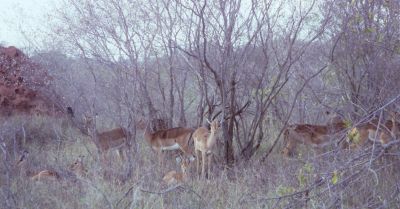
Impala |
Next, we saw a small group of
Impala. We didn't know it at the time, but they are the most common mammal in Kruger! There are over 150,000 of them here! Far more than any other species. We got bored with them fast and soon weren't even slowing down for impala. Unless, of course, they were blocking the way in the middle of the road! The impala is quite a unique antelope. Males have long lyre-shaped horns, averaging 75 cm in length. They are gregarious and form herds of 100 or more. The impala is known for its speed, and its ability to leap. It can leap over 10 meters and as high as 3 meters in a single bound! It is the favorite prey of lions, leopards, cheetah, wild dogs, and spotted hyenas.
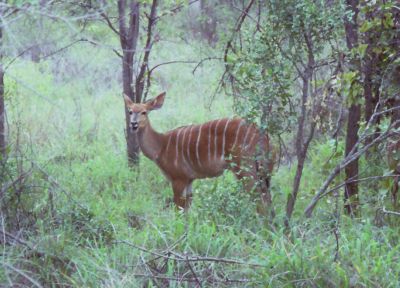
Nyala |
Next, we spotted
Nyala. This is one of Africa's rarest and most beautiful antelopes. The males are grey with a mane and long hair under the throat and hind legs, with vertical stripes down the back. They also have long, lyre-shaped horns with white tips. The females are ruddy color with vertical white stripes and no horns.
Next, we stopped at the Punda Maria camp for coffee and to see about reservations for tonight. We were able to get campground reservations for Letaba! Hooray!
After heading out, we came across a heard of
Buffalo. Our first "Big 5" sighting! They are quite large, and are gregarious, forming herds of 1000 or more. They have distinctive curving horns that broaden at the base and meet over the forehead in a massive "boss". We were used to seeing water buffalo in SE Asia, but these are very different!

Elephant |
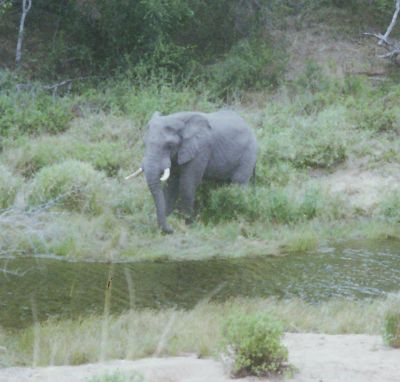
Elephant |
Next was another of the "Big 5" --
Elephants! The African elephant is different than the Asian elephant we have been used to seeing. Its ears are much larger and the elephant, in general, is larger. They herd in small family groups of 10 to 20, and have a matriarchal society. An adult's daily food intake is about 250 kg of grass leaves, bark, and other vegetation. They live for about 60-70 years.
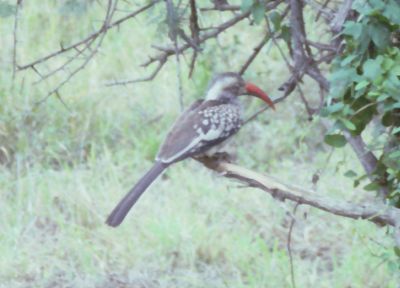
Red Billed Hornbill |
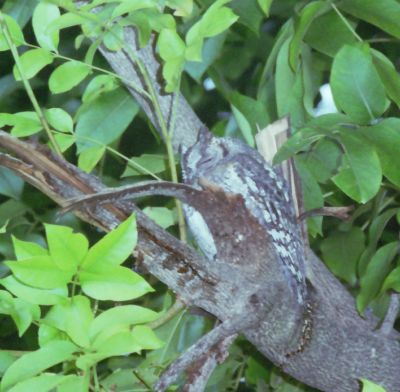
Scops Owl |
We stopped by the Barbalala picnic area for a rest, and while we were there we spotted some really cool birds! First we saw a
yellow billed hornbill. We also saw a similar bird, the
red billed hornbill. Next we spotted a gorgeous dark, midnight blue
Cape Glossy Starling. A girl in the parking lot showed us where there was a
Scops Owl sleeping in a tree. Then I spotted a
Little Bee Eater, it was tiny and very cute. We decided we had better get back on the road as we had 177 kilometers to go, and speed limits of 50km on paved and 40km on unpaved roads!
Our next stop was a waterhole along S56 where we spotted our first
Waterbuck. They are easily identified by the white ring around their rump and the white markings on their face and throat. Only the males have horns. It is a solid animal with a thick shaggy, dark-brown coat. We sat at the waterhole having lunch and watching the waterbucks and birds. We also saw a
Goliath Heron.
After lunch, Donna got her wish, we saw our first
Giraffe! We were both surprised at both how short and how dark it was! Later we realized that it seemed to be a juvinile male. Both sexes of giraffes have horns, though the females point more inward and have tufts.
Later on, we saw a
Grey Heron at another watering hole. It was gorgeous! We also saw
Hippopotamuses! We heard them first, they were snorting like pigs! There were
Nile Crocodiles, too. This was a fabulous waterhole right near the Letaba Rest Camp.
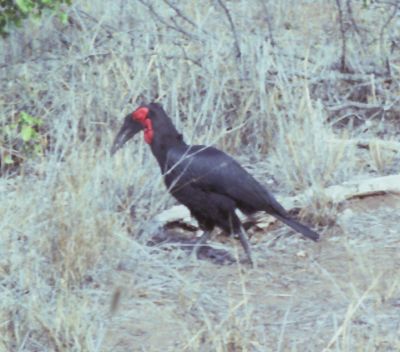
Southern Ground Hornbill |
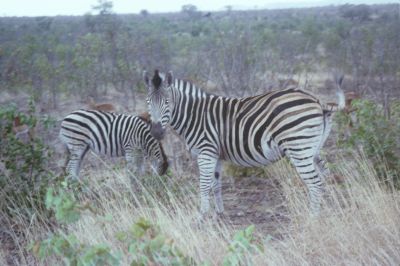
Burchell's Zebra |
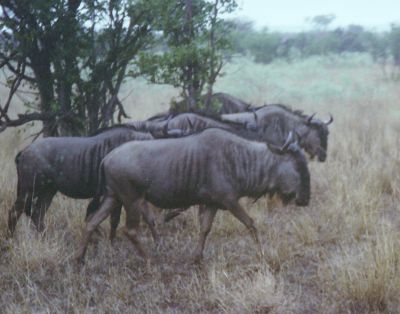
Wildebeest |
Our next sightings were a
Ground Hornbill and a
Burchell's Starling. Then we came across a herd of
Burchell's Zebras mixed with
Blue Wildebeest. Cool! The zebras are unusual in that they have shadow lines in between their black stripes. The social system centers around small groups of related mares over which the stallions fight fiercely. Stallions may hold a harem for as long as 15 years! Lions are their main predator. The blue wildebeest, on the other hand, is also quite gregarious, forming herds of up to tens of thousands in some parts of Africa, and it often associates with zebra and other herbivores. In Southern Africa, the herds are reduced and huge herds are a rarity.
The last animal we saw as we headed into Letaba was the
Vervet Monkey. We saw several by the side of the road. It is the most common of the monkeys of the woodland-savannah. The vervet is easily recognizable by its speckled grey hair and black face fringed with white. The male has a distinctive bright blue scrotum, an important signal of status in the troop. Troops may number up to 30.
We headed into Letaba about 15 minutes before they closed the gates for the night. They told us to find an open spot and pitch our tent. We found one along the exterior fence a bit away from all the others. There were many families with kids, as this was school holidays. I pitched the tent, and then started dinner (spaghetti), while Donna set up the rest of the stuff in the tent. Once she was done with that, she finished cooking dinner and I relaxed. We reflected on our day. We had seen and identified 22 different species! Awesome! However, we had been up since 4:00 AM, so right after dinner and cleanup, we headed straight to bed!
Sunday, July 13, 2003 Letaba to Pretoriuskop, Kruger Park, South Africa:
We got up LATE this morning, 5:15 AM.

We had breakfast, broke camp, and got out the gate a bit later than we hoped at 7:00 AM. The gates open at 6:00. We thought we had a long day yesterday (177km), well today we had to go 215km! Yikes! We decided to be a bit smarter, and spend the morning until 10 AM and the afternoon, from 3-5:30PM going slow on the dirt roads, and spend the hot midday on the paved roads at speed limit. That way, we would be going slow when the animals are active.
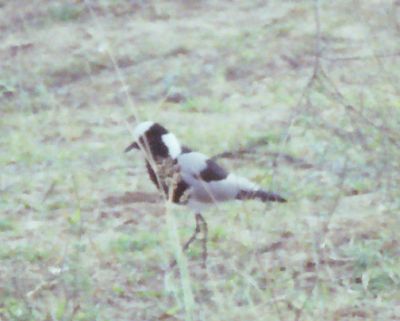
Blacksmith Plover |
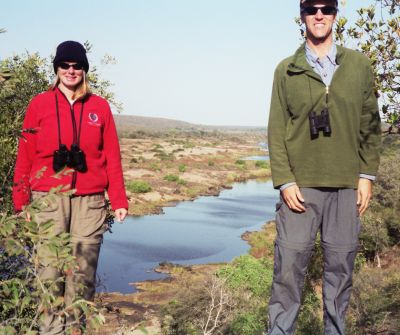
Olifant River, Hippos in Back |
Our first sightings of the day were a
Blacksmith Plover and a
Natal Francolin. Next, we saw more zebras, and then we found a beautiful view site - the Olifant River Viewpoint. At different spots, you are allowed to get out of your car and take a photo. "At your own risk", of course! We even took the opportunity to take a photo of ourselves! Next, we spotted more hippos downriver. It was extremely hard to get good photos of hippos on this trip. They seem to always stay at the extreme range of our telephoto! Also, everywhere we saw hippos, we also saw the Nile Crocodile! Most of the crocs are sleeping. I only saw one move the entire time we were there!
Of course, we saw many impala today. We didn't stop for them any more! We stopped at Olifants Rest Camp to get some groceries and use the facilities. They have an awesome viewpoint of the river right at the camp! No wonder they are always booked up there!
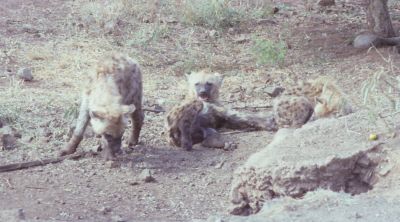
Spotted Hyenas |
Back on the road, we spotted some
Spotted Hyena right by the side of the road! The male was walking down the road, sniffing at the cars, and the female was lying down with the pups. Spotted hyena are known as scavengers, but are actually highly efficient predators with a fascinating social structure. The females are larger than, and dominant to, the males and have male physical characteristics. The most remarkable of which is an erectile clitoris (which makes the sexes virtually indistinguishable). Clans, which can contain dozens of individuals are led by females. The spotted hyena is massively built and appears distinctly canine, but is more closely related to cats than dogs. It can reach speeds of 60km/hour and a pack can easily dispatch adult wildebeest and zebra. Lions are its main natural enemy.
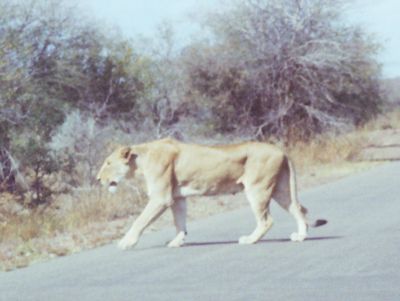
Lioness |

Lioness |
We were driving up a road and there were no oncoming cars and none close behind. We were looking for animals. When we spotted something rather large in the road ahead. "Is that a
lion?" "It IS a lion!" Cool! We got closer and she walked right out in the road in front of us. She was HUGE and beautiful! She kind of looked at us, and continued nonchalantly across the road as if she owned it. She crossed the road and continued on into the savannah. She took a few steps and paused. She looked back at us as if to say "See, I'm not so scary!" and then calmly, serenely continued on her way. Wow, we'd had our first lion sighting and it was a great one! A few other cars had pulled up by now, but we had certainly had the front row seat!
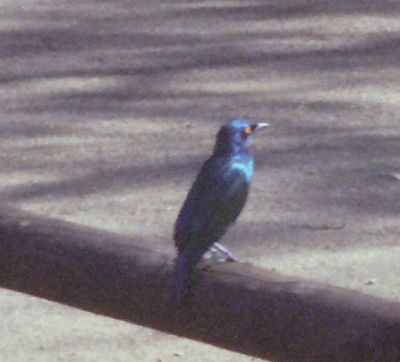
Cape Glossy Starling |
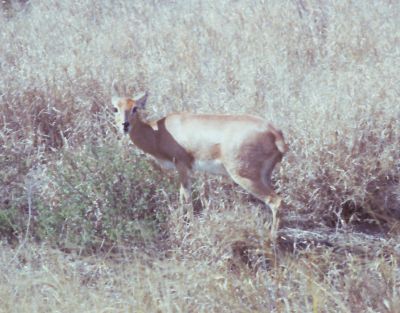
Sharpe's Grysbok |
There were lots of viewsites and water courses today. We stopped at N'wamanzi viewsite. We saw more hippos, crocs, etc. We saw an
Egyptian Goose, a
Grey Lourie, another cape glossy starling and more buffalo. We even saw a
Sharpe's Grysbok, a rather small fairly rare antelope. They're a bit harder to see at Kruger since they are so shy.
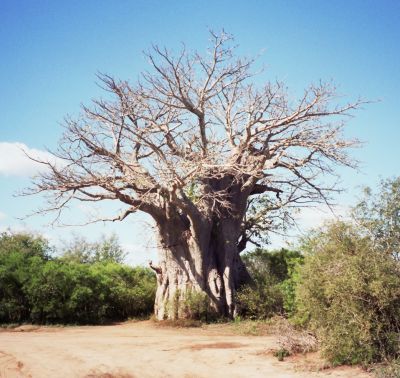
Southernmost Baobab Tree |
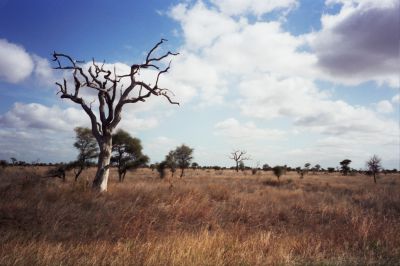
African Savannah |
Later, we stopped and looked at the "Southernmost Baobab Tree". Then, it was on further south that we saw another herd of wildebeest. It looked like they were a bit spooked. As we looked closer we saw
Warthogs! Cool! Man are they ugly! The distinctive facial warts can be used to determine the sex. Females have a single pair under the eyes, while the males have a second pair further down the snout.
Later on, we had a cool bird sighting of a
Fish Eagle. That was cool! It is a rather large bird, and looks kind of like a bald eagle.
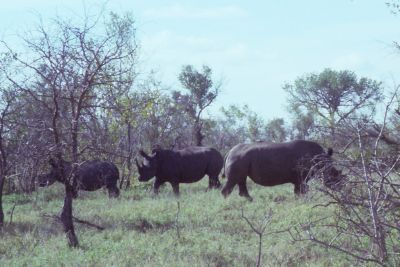
White Rhino |

Giraffe |
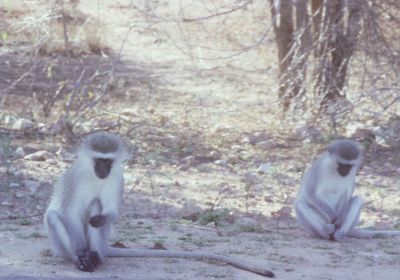
Vervet Monkeys |
We headed on and hit another traffic jam. This one was caused by three
White Rhinos! They were crossing the road and the male looked more than a bit agitated by all the attention. There appeared to be a male, a cow, and a calf. Once all three were across, the show didn't end there. The male started tossing his head as if he were going to charge one of the cars. Luckily he seemed to be all bluff and bluster. In fact, the white rhino is known to be the less aggressive of the two rhino species (black and white). An interesting way to tell the two species apart is that the young of the white rhino run in front of the mother while the young of the black rhino run behind their mother.
Our last big sighting for the day was an elephant at a waterhole. After that, we had to head straight to Pretoriuskop. We had 48 kilometers to cover and a 50km/hour speed limit. We had enough time to take a few dirt roads and stop at one more dam, and we pulled in to Pretoriuskop right at 5:30 PM! We checked in and were assigned hut 84. The huts here are cylindrical rooms with two twin beds a table, two chairs, and a sink. We put the beds together and then went down to the shared kitchen and made dinner. We thought of doing a night ride tonight since it was clear with a full moon, but we were just too tired. I signed us up for the night drive for the next day. We tried sleeping with our two mattress pads on top of the beds to cover the gaping hole in the middle, but this ended up too soft and taco-like. We kept migrating to the middle!
We had seen 34 species today!
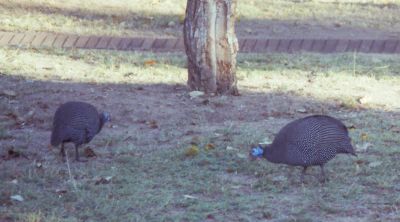
Helmeted Guineafowl |
Monday, July 14, 2003, Pretoriuskop & Night Ride:
We got up a bit later today, 6:30. We were both beat from the last two mornings. We finally rolled out of the gates around 8:00 AM, but Donna had already had our first sighting. A group of
Helmeted Guineafowl. They are huge interesting birds that seem to be as intelligent as a turkey, i.e., NOT! We were quite excited about getting out today. There was always so much talk about how many animals there are in the south. Especially the Big 5! We'd seen one lion, many buffalo, elephants and rhino, but we had yet to see a leopard.
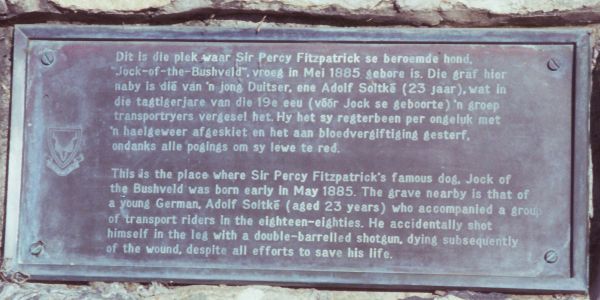
One of Jock's MANY Plaques |
We headed out and then down H2-2 (Voortrekker Road). It turns out that there are quite a number of historical markers and sites along this route, as well, so we stop to see them as we go. Donna tells me that "Jock's birthplace is coming up." Jock seems to be a very important man. He has a marker for his birthplace, and grave, two plaques, a statue, a concession and lodge named after him (
Jock of the Bushveld). We're looking forward to learning a little more. The first thing is his birthplace.
UNBELIEVABLE! Jock is a
DOG! All of this hype over a dog that lived in the 1880's! Go figure... The rest of the day, the whole route we were on, we kept seeing markers "Jock Trek", Ha!
Well, at least that kept us busy for a while, because we sure didn't see a whole lot of wildlife! Sure, we saw impala. We
always see impala. That's the one thing you know you'll see - Impala! We even saw a couple of Kudu, but beyond that, mostly all we saw for quite a long while, was birds. The
Fork-Tailed Drongo,
Crested Barbet, Blacksmith Plover,
Bateleur, Red Billed Hornbill, Yellow Billed Hornbill,
European Bee Eater, and
Carmine Bee Eater.
Finally, we saw some zebras. Then, we spotted something we hadn't seen before, we spotted a
klipspringer! Klipspringers are a small species of African antelope and are quite sturdy. You can recognize them by their curious tip-toe stance. Only the males have horns. They are usually found on rocky areas, but occasionally venture into adgacent grasslands. It is amazingly agile and sure footed and is capable of bounding up impossibly rough rock faces. Males and females form long lasting pairs and occupy territory together. The female is larger than the male. They saw us though and ran away quickly.
We saw a really gorgeous
Giraffe.It was much taller and lighter in color than the ones we saw the day before.
More bird spottings of a Black Flycatcher and a
Long-Tailed Shrike. Then we saw a really cool lizard. I had to slow down and swerve to avoid hitting it in the road. Then we maneuvered to try and get its photo. Of course, none of our material has anything to help us identify it. Next, we saw
Chacma Baboons. They live in troops of up to 150, and there is no single dominant male.
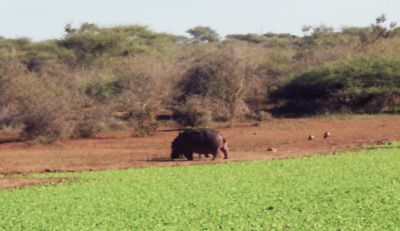
Hippo |

Warthog |
When we got back to the Skukuza water hole it was already getting a bit late, but we encountered a HUGE herd of elphants. There were probably 10-15 cows with babies. There may have been some bulls in the herd, too, we aren't sure. They were clearly trying to get the calves across the road safely and keep them away from the cars. We stayed and watched for a while and then headed for Pretoriuskop. We did see another buffalo herd along the way back. When we hit the Skukuza turn off, we realized we had 48 kilometers to go in 60 minutes. The speed limit is 50 kilometers an hour! With a tiny bit of speeding, we were able to make it into the gates at 5:30 on the dot!
We had trouble deciding what to do for dinner. They had no mince in the store, and the restaurant only had a buffet that cost 85 rand per plate! ($13.28) So, we went back to the store, and bought some sliced ham and had ham and cheese sandwiches and played palace until it was time for the night drive.
Donna was a bit worried that we had chosen to do the night drive from Pretoriuskop, as there were very few animals near here, and they aren't going to be able to get very far from the camp in 2 hours.
It took them a while to get organized before we headed out, but eventually we left. We were in two of the game viewing trucks. Donna and I were in a big one, and there was also a small pickup-based one. It was clear and the full moon had risen by the time we left. I got to man one of the spotlights on our side of the vehicle. They have two spots that are fixed to the truck, and then four that they hand out to passengers. Spotting animals can be much easier at night than at day. Their eyes reflect the light from the spots. So you just scan it out there and look for eyes. When you see them, you yell "Stop!" and they stop and figure out what it is. We saw rhino, elephants, impala (of course!), several small owls (probably scops owls), a scrub hare, buffalo, zebras, and a very small antelope they identified as a common duiker, but we think it might have been something else. Later we saw a red
Common Duiker, and it was easily 2-3 times the size of the one we saw at first. The common duiker is usually solitary, but is sometimes seen in pairs. It is greyish/light brown in color, with a white belly and a dark brown stripe on its face. Only the males have horns.
Next, we saw a
Reedbuck. The common reedbuck is found in wetlands and riverine areas. The underbelly, underside of the thights, throat, and underside of the tail are all white. The males have distinctive forward curving horns. Common reedbucks live in pairs in their territories. Next we saw a
barn owl, unfortunately it flew away before we could take a picture. It was quite beautiful. The trip was quite cold, we had on all our fleece, but it probably would have been better if we brought a blanket from the room, too.
We had seen 32 different species today.
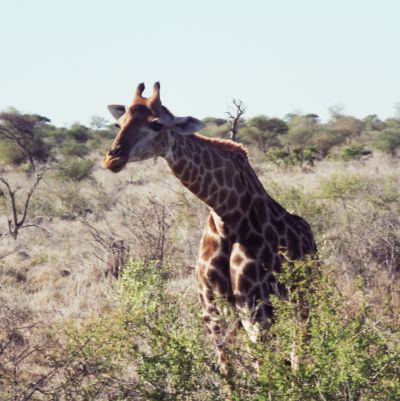
Giraffe |
Tuesday, July 15, 2003, Pretoriuskop to Skukuza, Kruger Park, South Africa:
We got up early today, packed and headed out. We didn't yet have accommodation for the night, but we would take care of that at a rest camp during the day. We saw several helmeted guineafowl while we were leaving camp. Our first sighting outside was an elephant that was going to town, eating a tree. We watched him for quite a while. Next, was a thrilling experience, we spotted a herd of 11 giraffes! They were gorgeous! We watched them cross the road, and then slip off into the foliage. Next, we saw a fish eagle, a
Cape Turtle Dove, an egyptian goose, a crested francolin, more kudu, tons and tons of impala, buffalo, a blacksmith plover, and a skink we almost ran over.
We stopped at the Lake Panic Hide to see what might be there, and on the way we spotted a
bushbuck. Bushbucks are shy and solitary. They inhabit thick bush close to water. They are chestnut to dark brown, and have a variable number of white vertical stripes on its body between the neck and rump, as well as a number of white spots on the upper thigh. In the hide, we saw more fish eagles, egyptian geese, a bateleur, cape glossy starling, baboons, crocodiles, and yellow billed hornbills.
We went to Skukuza rest camp. Both Satara and Orphen were full. Skukuza said if we could find an open space there, we could have it. We drove around the camping area and there were tons of open spots. We chose one and pitched the tent, and then picked up some groceries, paid for our site, and we were on the road again.

Waterbuck |
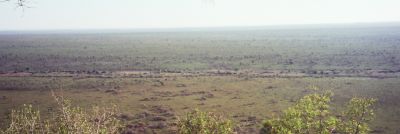
African Savannah |
We saw many more animals today, including: elephants, hippos, waterbuck, giraffes, carmine bee eaters, cape glossy starlings, saddle billed storks, zebras, blue wildebeest, spotted hyenas, goliath herons, natal francolin, red billed hornbills, long tailed shrikes and vervet monkeys. We were going to spend our last hour at the Skukuza water hole.
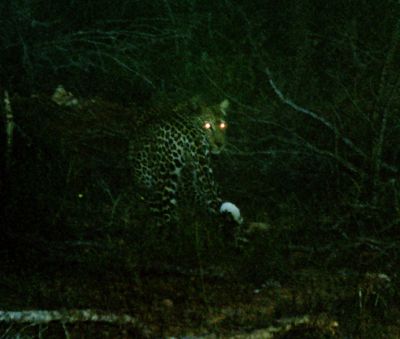
Leopard! |
As we came down H1-2 on the north side of the waterhole, just after we crossed the Sand River, a leopard crossed the road right in front of us! I told Donna to get out the camera (her nose had been in the map). He was walking up the embankment, and we pulled up and she took several flash pictures. before he disappeared over the hill. He was beautiful! And close! At one point, he even looked back at us. Cool! We had seen all of the Big 5!
Now we really had to hurry back. We pulled into the camp at 5:29! It was nice to already have the tent pitched. Dinner was steak and potatoes that I cooked. Very yummy!
We had seen 34 species today.
Wednesday, July 16, 2003, Skukuza to Pretoriuskop, Kruger Park, South Africa:
Today was our last full day in Kruger Park! We got up at 5:15, had breakfast, and broke camp. We were out the gate by 6:45. Of course, the first thing we saw was impala. Big surprise. But, we heard a really weird noise and we couldn't figure out what it was, so we opened our windows. It was a loud snorting noise. We looked around, and it was the impala stag making the noise! We sat there watching and listening while he herded his females around making this obnoxious noise.
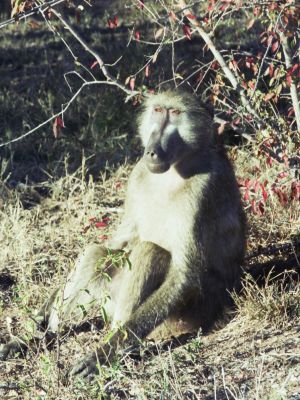
Baboon |
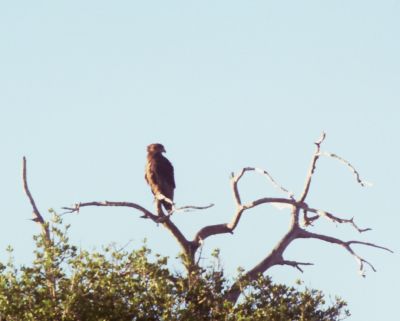
Waldberg's Eagle |
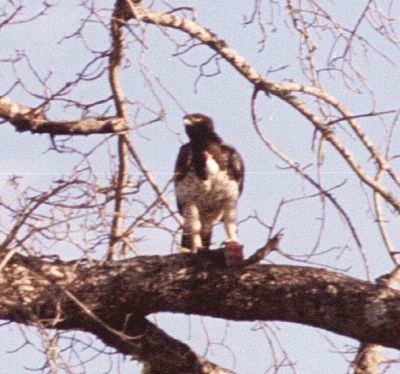
Martial Eagle having lunch |
We went to the north side of the waterhole first. We saw the common duiker, the Hadeda Ibis, a ton of helmeted guineafowl, some of which flew up into the branches of a dead tree. They were so heavy it looked like they were going to topple the tree over! We also saw a yellow billed hornbill and more baboons. Then, we saw a new eagle. It took us a while, but we identified it as a
Wahlberg's Eagle. Next we spotted a
Martial Eagle. This was cool because it was sitting on a branch eating the back half of a very large iguana! Here it would be called a
tree monitor probably. The back half means about the back 3 feet! From the rear legs to the tail! Next, we spotted an
African Goshawk. Wow! There were a lot of cool birds of prey here!
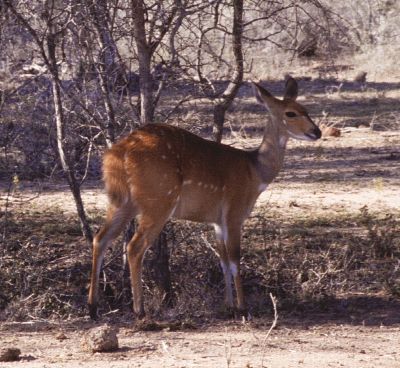
Female Bushbuck |
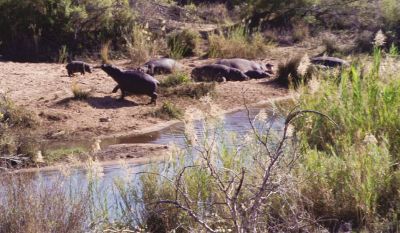
Hippos |
Next, we went to the south side of the Skukuza watering hole and saw a big traffic jam. When we got up to it, we figured out what it was for. There was a leopard sleeping down on the riverbank. We got out and went up to the cliff to view it like several other people were doing, and on our way back to the car one of the guided safari tour guys yelled at us to get back in our car! We told him that is just what we were doing! A little further on, we saw some egyptian geese, buffalo, hippos, and kudu. Then, another traffic jam! This time it was a lioness! We worked our way up into the crowd of cars, and we stood on our door jams in order to see. Donna spotted it down in the bushes. I never did see it as the annoying safari guy came up and continued to hassle us. We left shortly thereafter. We had two more leopard sightings that day.
We went across the river and then down a dirt road, and eventually spotted a new animal. It was a
Black Backed Jackal! Unfortunately by the time we got up to them, they were too far away for a photo. The jackal relies heavily on scavenging, but is also an efficient hunter, taking insects, birds, rodents, and even the occasional small antelope. Pairs of jackals form long-term bonds, and each pair occupies an area varying from 3 to 21 1/2 square kilometers. Litters are from 1 to 6 pups and are looked after by their older siblings as well as parents. Later we saw a grey lourie, darter and goliath heron. Then Donna yelled "Stop!" This one was fast. It was a
secretary bird. Unfortunately, we didn't manage to get a photo.
As we were heading into Lower Sabie, a strange thing happened. We came across a queue of impala crossing the road. Yes! A queue! there were about 20-30 impala on the left and 40-50 on the right. They were crossing the road, single file, right to left! Cars were backed up watching. This was going to take FOREVER! I passed the waiting cars in front of us, edged up to the queue and made our way through. We weren't going to wait for impala!
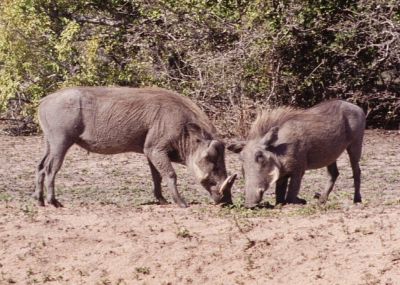
Warthogs, right one is kneeling |
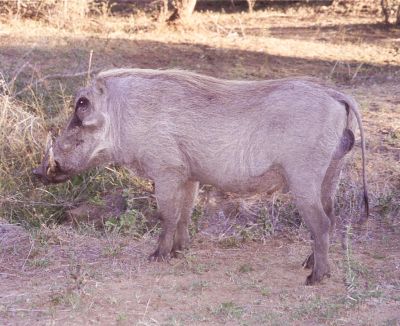
Male Warthog |
At Lower Sabie, we stopped and saw some warthogs. Males this time! Warthogs are interesting in that as they forage for certain types of food, they will drop down onto their front knees. As we circled the waterhole, we saw a troop of baboons seemingly out on a hike. They were walking single file along the side of the road. They are usually just sitting there watching, but these guys were on a mission!
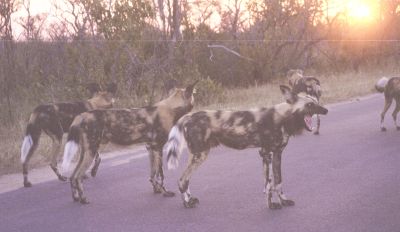
Wild Dogs |
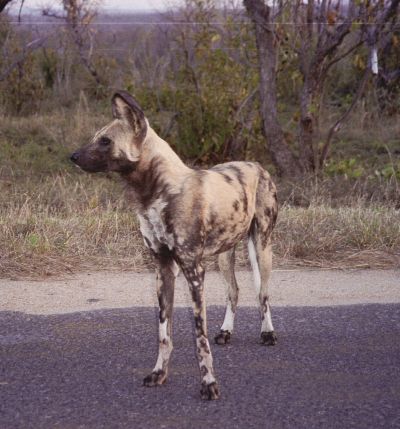
Wild Dog |
It was late and we were on our way back to Pretoriuskop. We passed another traffic jam that was watching a lioness stalk a buck. We couldn't stop. Along the way, we saw some more elephant, but then we had to stop because there were
Wild Dogs in the road! They were much different than the hyenas. They were very active, trotting in amongst the cars, playing with each other, sniffing at the cars, etc. They were acting like very curious, ordinary dogs. They are very sociable, live in packs of up to 40, and are great endurance hunters. They can reach speeds of 65 km/hour for up to 5 kilometers or longer! The pack will chase prey to the point of exhaustion and then bring the prey down through cooperation. They are efficient and effective hunters, bringing down 85% of their prey. As a result many parks have eliminated their wild dogs, making them one of Africa's rarest and most threatened species.
It was getting late and we had to hustle, but on the way we were stopped by yet another wonderful species. The white rhinos! Cool! Now it has been a Big 5 Day! No time to spare though, we looked and then headed off. Along the way we saw more buffalos. We pulled in the gate at 5:30, and the guard looks at us shaking his head as he pulled the gate closed behind us.
One aside: We had heard a news report of some lions being sighted in Hazyview earlier in the week. That's a town about 18km outside of Kruger. They were trying to capture them and figure out where they came from. Well, most of the rest camps have sighting boards where you put colored pins in for animals you have sighted. At one of the camps that day, someone put a lion pin in Hazyview. It was hilarious!
This time we were in a different hut. We settled in and had scotch filets and pasta for dinner, I cooked the meat and Donna handle the pasta. We were going to get up at 4:30 AM the next morning and head out so we could do a game drive until 10 AM and then get on the road back to Pretoria.
We saw 36 species today including all of the Big 5!
Thursday, July 17, 2003, Pretoriuskop, Kruger Park to Pretoria, South Africa:
Boy is 4:30 AM early! We got up, and I packed the car while Donna made breakfast. We were waiting at the gate at 5:40. At 5:55 they opened it and we were out heading to the waterhole. Along the way, we saw some spotted hyena, aparrently out hunting. Then, we saw a long tailed shrike and two klipspringers.
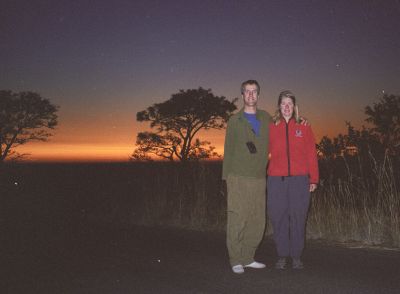
Sunrise 7/17/03 |
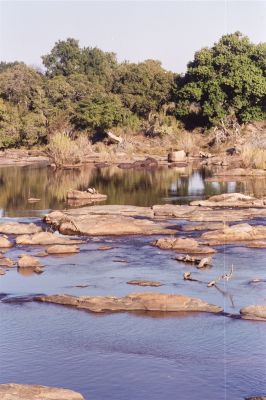
Hippos |
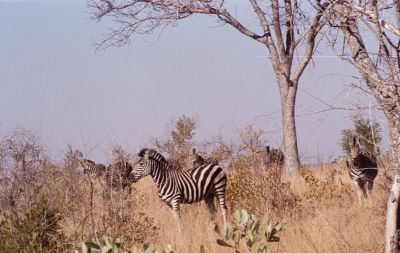
Zebras |
At a nice viewpoint, I stopped and we took a sunrise shot with both of us in it. Donna was a bit nervous about being out of the car, but the coast was clear.
We saw more crested francolin, egyptian geese, blacksmith plover, helmeted guineafowl, and a fork tailed drongo. Then, I spotted a
Pied Kingfisher and then an unusual bird called a
Hoopoe. Next, we spotted another leopard. That was our third day in a row with leopards! He was across the river laying in the cool sand.
We saw a nyala, which we hadn't seen since the first day, and more hippos, a hamerkop, bushbuck, the ever-present impala, a red-eyed dove, ground hornbill, baboons, elephants, goliath herons, giraffes, kudu, great white egret, and burchell's zebra! We pulled out of Numbi gate at 10:30 AM to leave the park.
We had seen 25 species just this morning!
It was very weird to leave Kruger Park. First of all, for the last 6 days, we had been driving less than 50km/hour everywhere. When you pull out of Kruger, the speed limit almost immediately goes all the way up to 120 km/hour! That seemed VERY FAST! The scenery doesn't fit either, you aren't used to houses, people, pedestrians, etc. And worst of all, the only animals you get to see are cows, dogs, and the occasional horse or donkey! Maybe we should have gone through Hazyview! Ha!
We had a pleasant drive, and continued listening to the news on the hour. I had turned on my watch chime, so we could turn off whatever we were listening to and catch up with the news. There are quite a few problems going on in Africa now (e.g., the coup that happened recently in Sao Tome, and another story about police killing protesters in Nigeria, and lots of others). We stopped for lunch at a roadside stop along the tollway and ate at BJ's; it is attached to the Caltex Starmart. When we pulled in for gas, I asked them to fill it up; there is no self-serve here. They proceded to wash the entire car right there at the pump while it was filling! Amazing -- not just the windows, but the whole car! He probably did it fishing for a tip, which he got, but it was great service!
We arrived at Marlene and Glenn's at around 4 PM, we rang the bell, but no one was home, so we parked by the driveway and read our books. I was reading the 4th Harry Potter book (Goblet of Fire) and Donna is reading The Covenant by James Michener. Marlene and Glenn got home around 5:30 and we pulled in after them. We unloaded the car, checked our email and settled in to their guest room. Dinner was delicious! Chicken, pumpkin, and greenbeans with feta cheese. For dessert we had something called a Milk Tart. Looks like a cheese cake, but much lighter in consistency and flavor. We ate that and drank tea while we watched the highlights from the
Tour de France. Lance was still in the lead, but it was a very close race!
Friday, July 18, 2003, Pretoria, South Africa:
We had to get up early again today; no sleeping in for us, at least not yet. We had to return the car today. Also, we wanted to check into mailing off some stuff to the US. After breakfast, we collected all the stuff to ship and put it in our Lao luggage and headed out the door. We had read in the Lonely Planet, and heard from Marlene, that shipping from South Africa via the post office isn't very safe. So we looked into shipping it via PostNet, a commercial shipper here. Their quote was $211 or $268. Ouch! We decided to carry it to Egypt; that was way too much. We took the bag home and dropped it off. We went to find a post office anyway in order to buy an aerogram. While there, we asked how much our 8.5 kilo package would cost to ship. They charge $140 airmail or $38 seamail (both are tracked and insurable). We decided to go for the $38 seamail option. We went back again to the house, got the bag and hurried back to the post office. Unfortunately, this was the first post office we had been to that does not have ANY packing material. I had to go look for a box and one of the clerks let us borrow some tape. After shipping the box, we filled up the car with gas and returned it to the rental agency. They were nice to give us a ride back to Glenn and Marlene's place where we spent the rest of the day, updating the journal and sending a post to the list.
This day, July 18, was a very important day in South Africa. It was Nelson Mandela's 85th birthday! The entire country went Mandela-Crazy. All the papers had it on their headlines, it was all over the TV, and people even had t-shirts commemorating it. Glenn whose consulting firm works on bridges was going to be opening the Nelson Mandela Bridge on Sunday.
Julia was working today, and she washed all our laundry. Later in the afternoon, Donna noticed her ironing some clothes, so she went in and told her not to iron ours. She seemed skeptical but said okay. Later on Donna saw that Julia had ironed all of our clothes anyway. They hadn't been ironed ever! As we were packing, I showed her what we do with our clothes and why it made no sense to iron them. (We stuff them in stuff sacks in our packs).
That evening when Marlene and Glenn came home, we had a braai (Barbeque). They invited their neighbor Kathy, and her two kids, Zoe and Tegan over, too. Kathy brought Droewars over. It is a dried meat, similar to Slim Jims in the States, but not as spicy. But here, it is made from game meat and it's a delicacy. The dinner was great! There were wors (sausage), pork chops, sosaties (skewered beef), plus some amazing garlic/cheese bread. It was a feast!
In the living room with tea and coffee watching the days results from the Tour de France, we had dessert. Yay, we wouldn't have to set our alarm tomorrow!
Saturday, July 19, 2003, Pretoria, South Africa:
We got up around 8, and had breakfast. Not our usual Peanut butter on toast for Donna and cereal for me, but a feast! Marlene made scrambled eggs, toast, bacon, juice, papaya. Yummy!
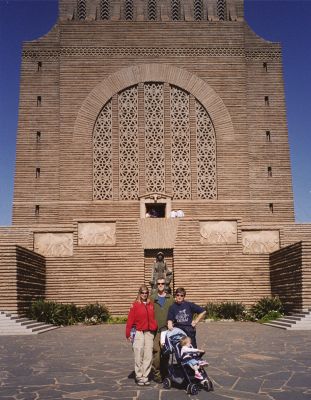
The Voortrekker Monument |
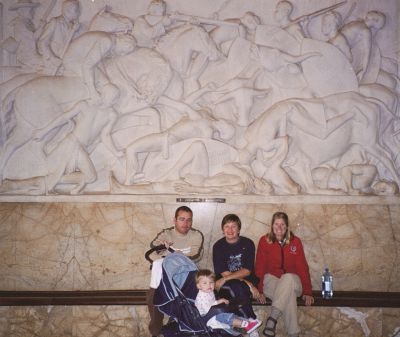
One of the reliefs inside |
After breakfast, we packed our packs so they would be ready at a moment's notice. Then, we all went for a tour around Pretoria. It was Marlene, Glenn, their daughter Mia, and Donna and I. Our first stop was the
Voortrekker Monument. This is "Holy Ground" for many Afrikaners. It was built betweeen 1938 and 1949 to commemorate the achievements of the Boers, who trekked north over the coastal mountains of the Cape into the African Veld. In particular, it commemorates the Battle of Blood River, during which on Dec 16, 1838, 470 Boers under the command of Andries Pretorius defeated approximately 12,000 Zulus. Supposedly, 3 trekkers were wounded and 3000 Zulus were killed. The trekkers went on to found independent republics that in many ways form the genesis of the modern South African states.
The edifice of the monument is surrounded by a stone wall carved with 64 wagons in a traditional defensive laager (circle). The building itself is a huge stone cube inspired by the ruins of Great Zimbabwe. Inside a detailed bas-relief tells the story of the trek, and the battle of Blood River. On December 16, and only that day, a shaft of light falls from the ceiling through a small hole on to a tablet engraved with the words "Ons virjou, Suid Afrika" (We for thee, South Africa). A staircase and elevator take you to the roof for a fabulous view of Pretoria. From there, we could see the burned out shell of the monument's restaurant that had burned a few weeks ago. In the basement, they have a nice museum about the trek with lots of artifacts from it. All in all, it was a nice monument.
We had some snacks at the local snack bar. Then, we headed over to the
Union Buildings, which are the government headquarters in Pretoria. The structures are sandstone, quite substantial, and unfortunately, due to recent security concerns, completely closed off to the public. We couldn't even get close enough to take a decent picture. However, we did go for a short walk in the expansive gardens that surround the place. On the way back to the house, we drove by the US Embassy, which didn't look as fortressy as the others we have seen. It was very crowded there as there was a South African Springboks vs New Zealand All Blacks rugby game going on.
We went back to the house, hung out, checked email, made sandwiches for the plane ride, and watched the Tour De France, LIVE! All too soon, it was time to go. We piled into the car with Marlene and Glenn and Mia, and we were off to the airport. Marlene and Glenn are so great -- they didn't just drop us off, but parked, and went in with us! After we checked our bags, we went up to the observation deck and watched the planes. Finally it was time for us to go. We said our goodbyes, and encouraged them to come visit us in the States! We went off to find our gate. We were on Lufthansa this time. After changing our seats to include an aisle seat we boarded the plane and were ending our adventure in South Africa. It was a great time! Next stop Egypt!
If you are reading chronologically, click here.









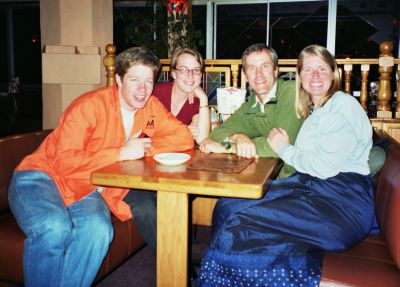




















































 We had breakfast, broke camp, and got out the gate a bit later than we hoped at 7:00 AM. The gates open at 6:00. We thought we had a long day yesterday (177km), well today we had to go 215km! Yikes! We decided to be a bit smarter, and spend the morning until 10 AM and the afternoon, from 3-5:30PM going slow on the dirt roads, and spend the hot midday on the paved roads at speed limit. That way, we would be going slow when the animals are active.
We had breakfast, broke camp, and got out the gate a bit later than we hoped at 7:00 AM. The gates open at 6:00. We thought we had a long day yesterday (177km), well today we had to go 215km! Yikes! We decided to be a bit smarter, and spend the morning until 10 AM and the afternoon, from 3-5:30PM going slow on the dirt roads, and spend the hot midday on the paved roads at speed limit. That way, we would be going slow when the animals are active.































